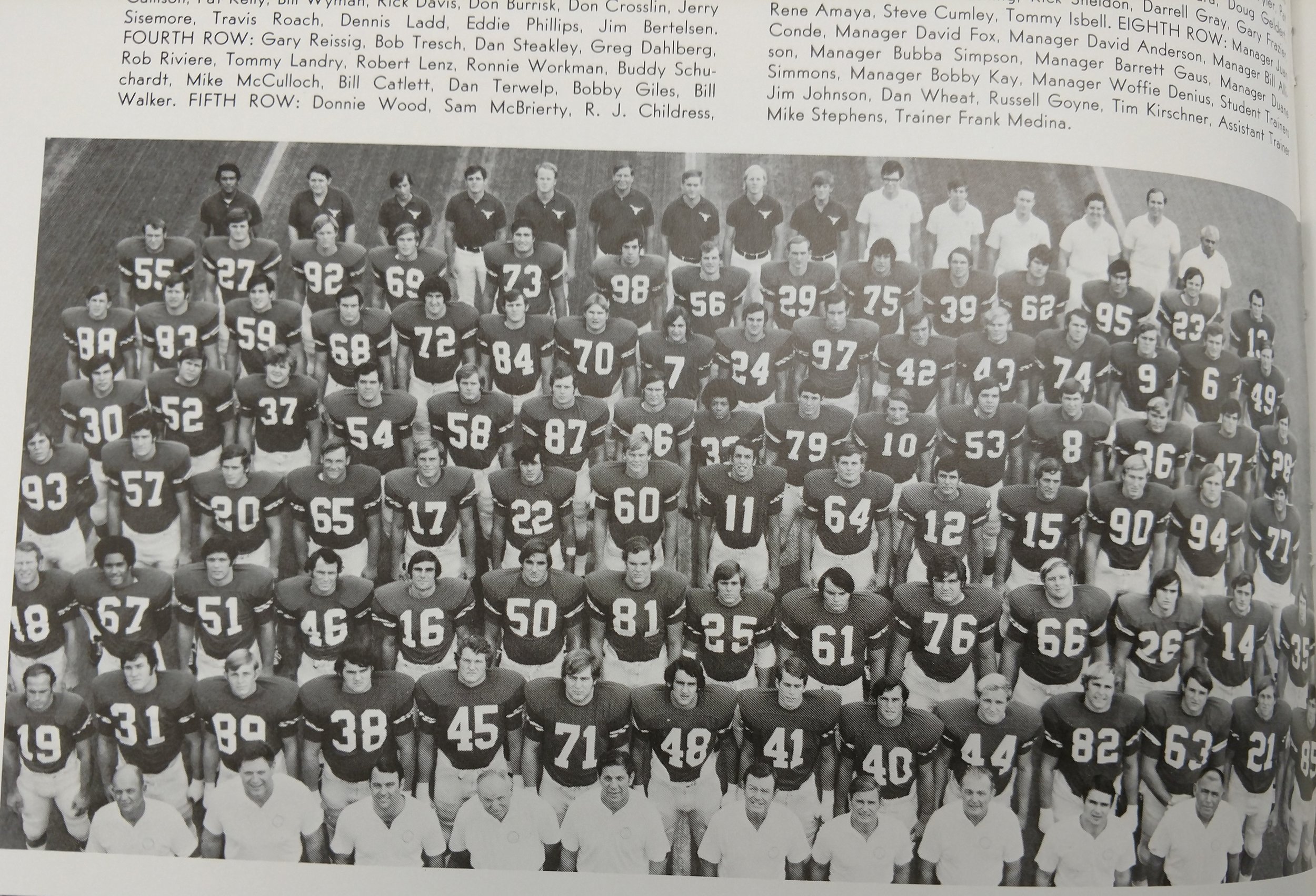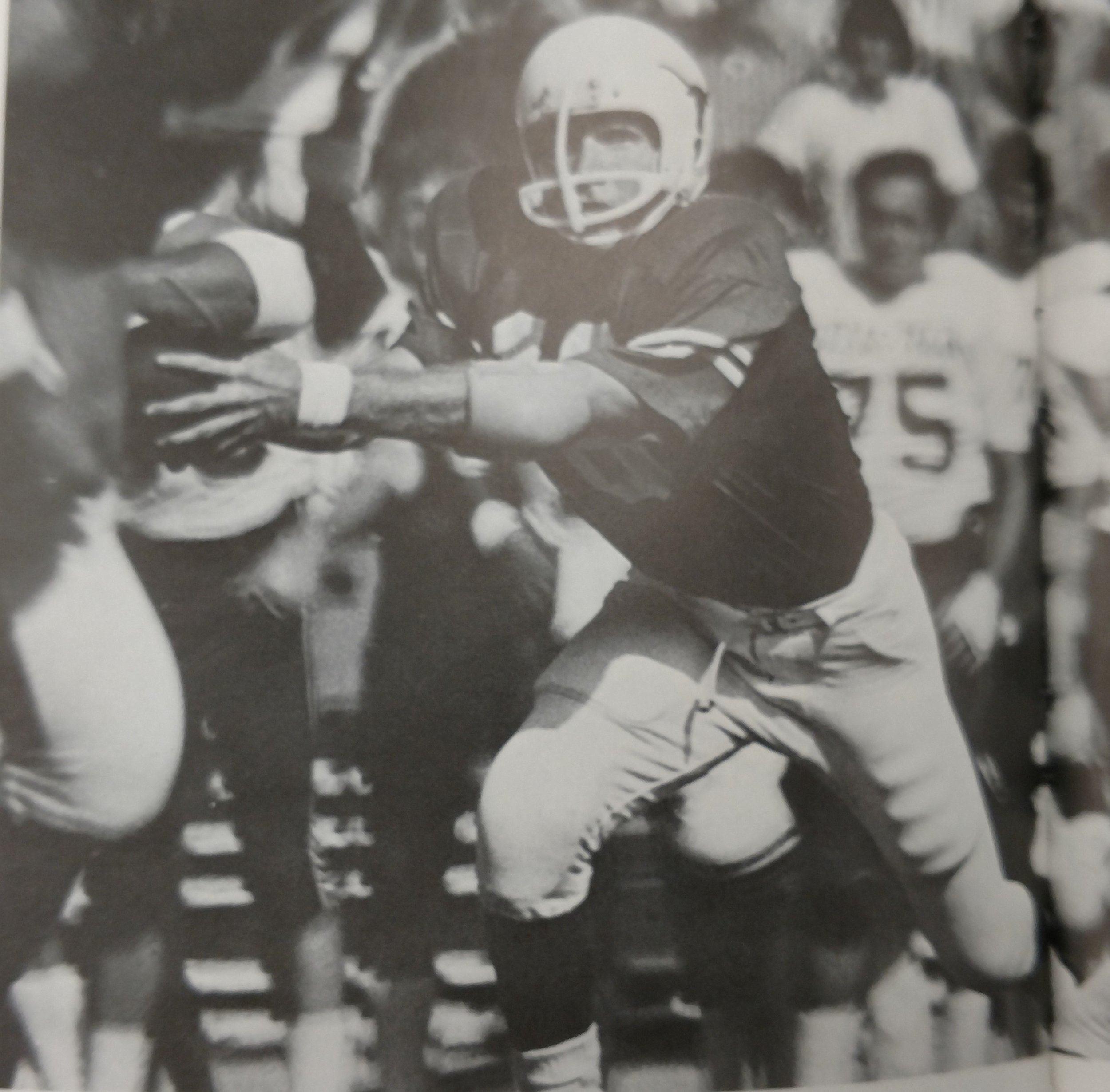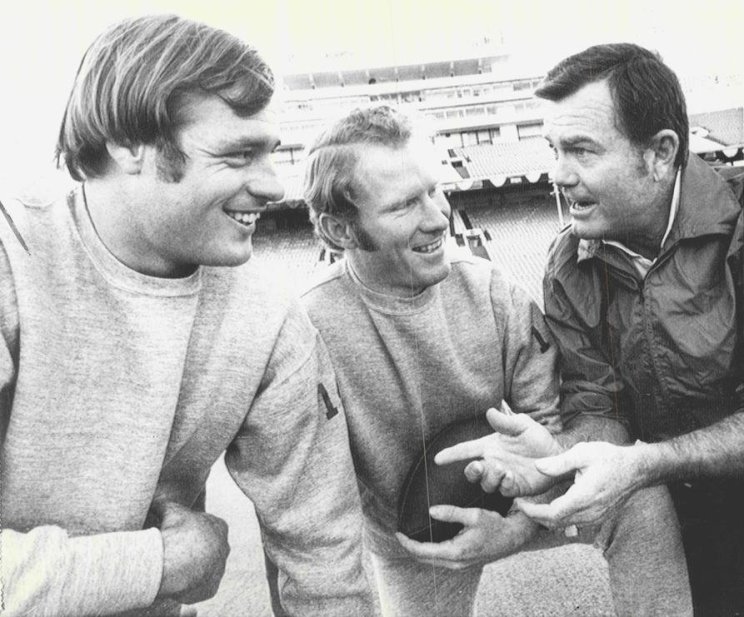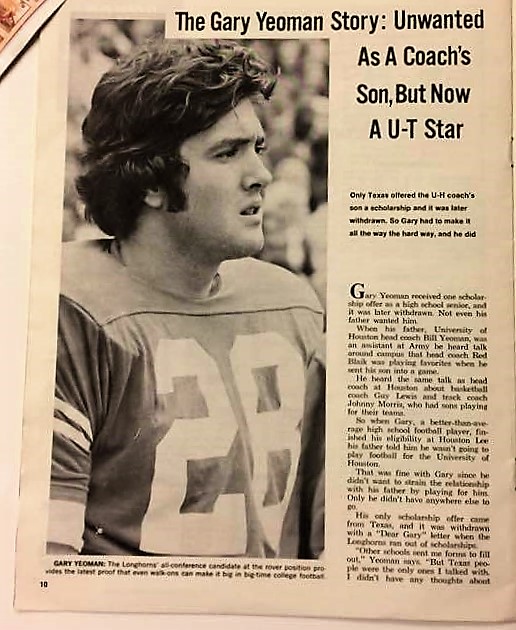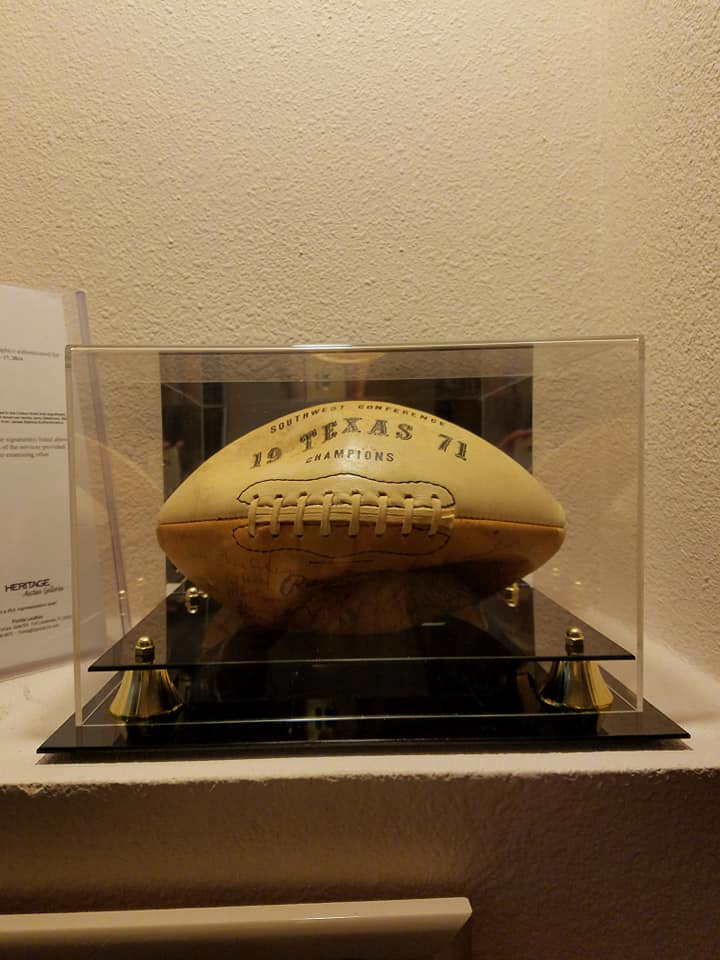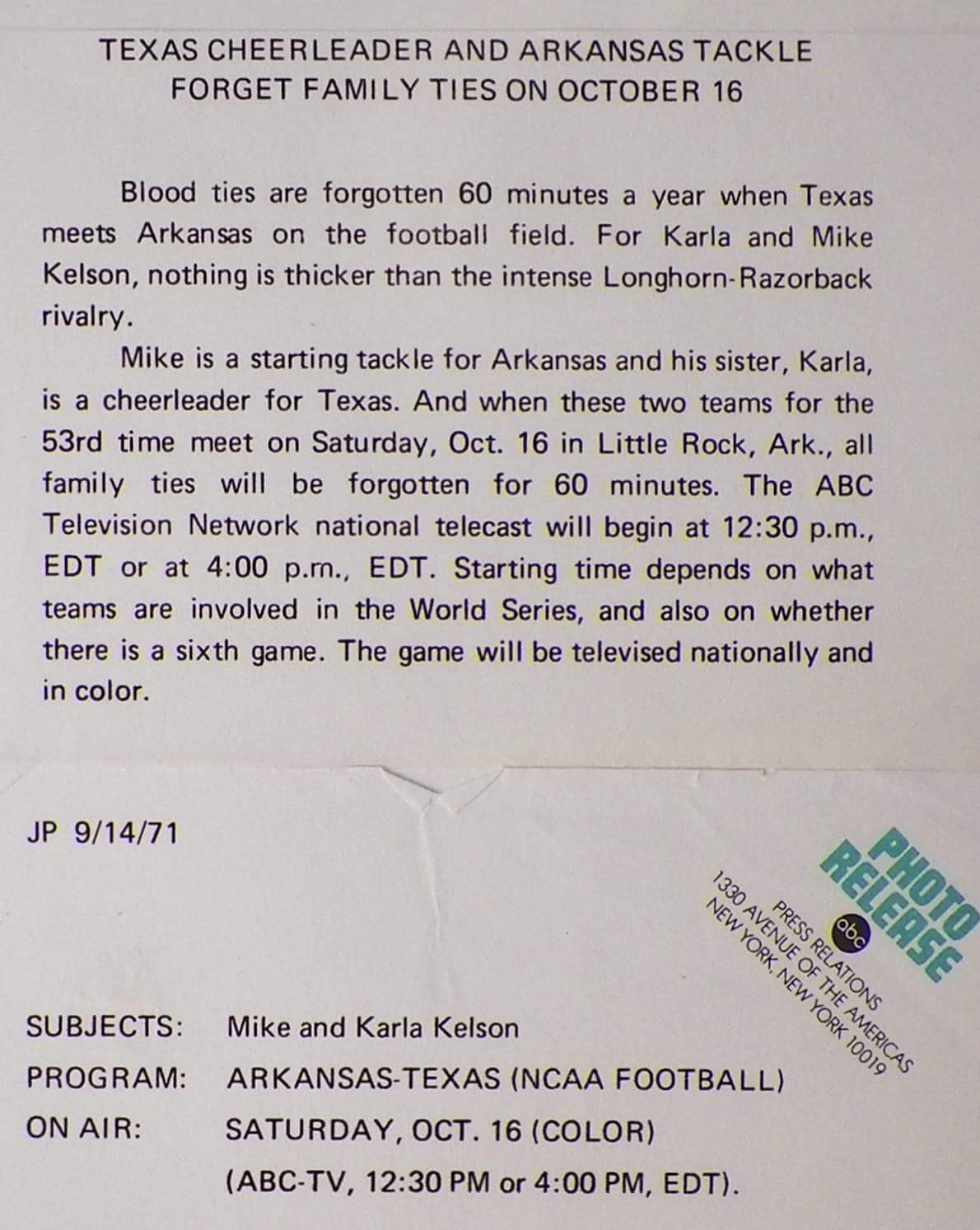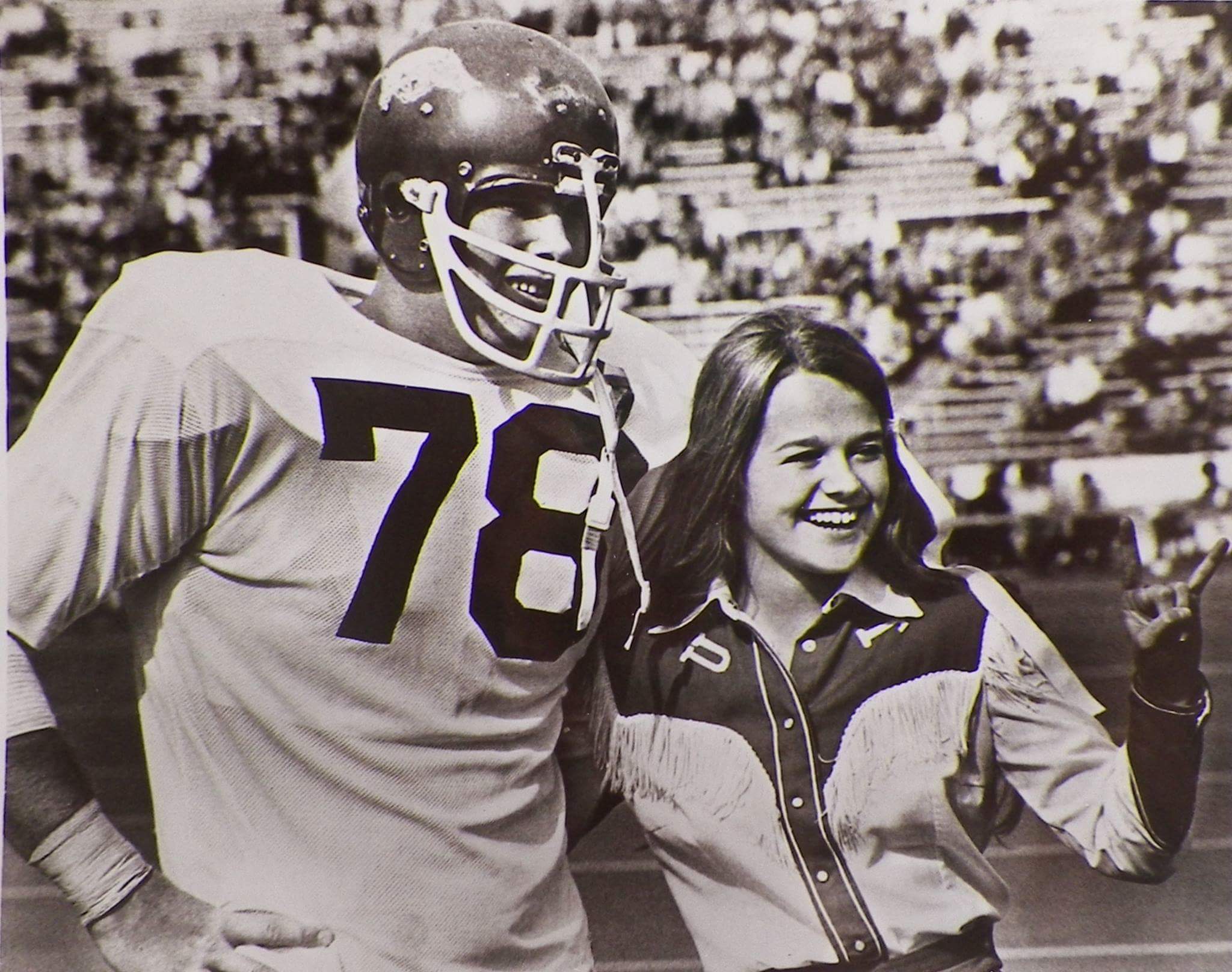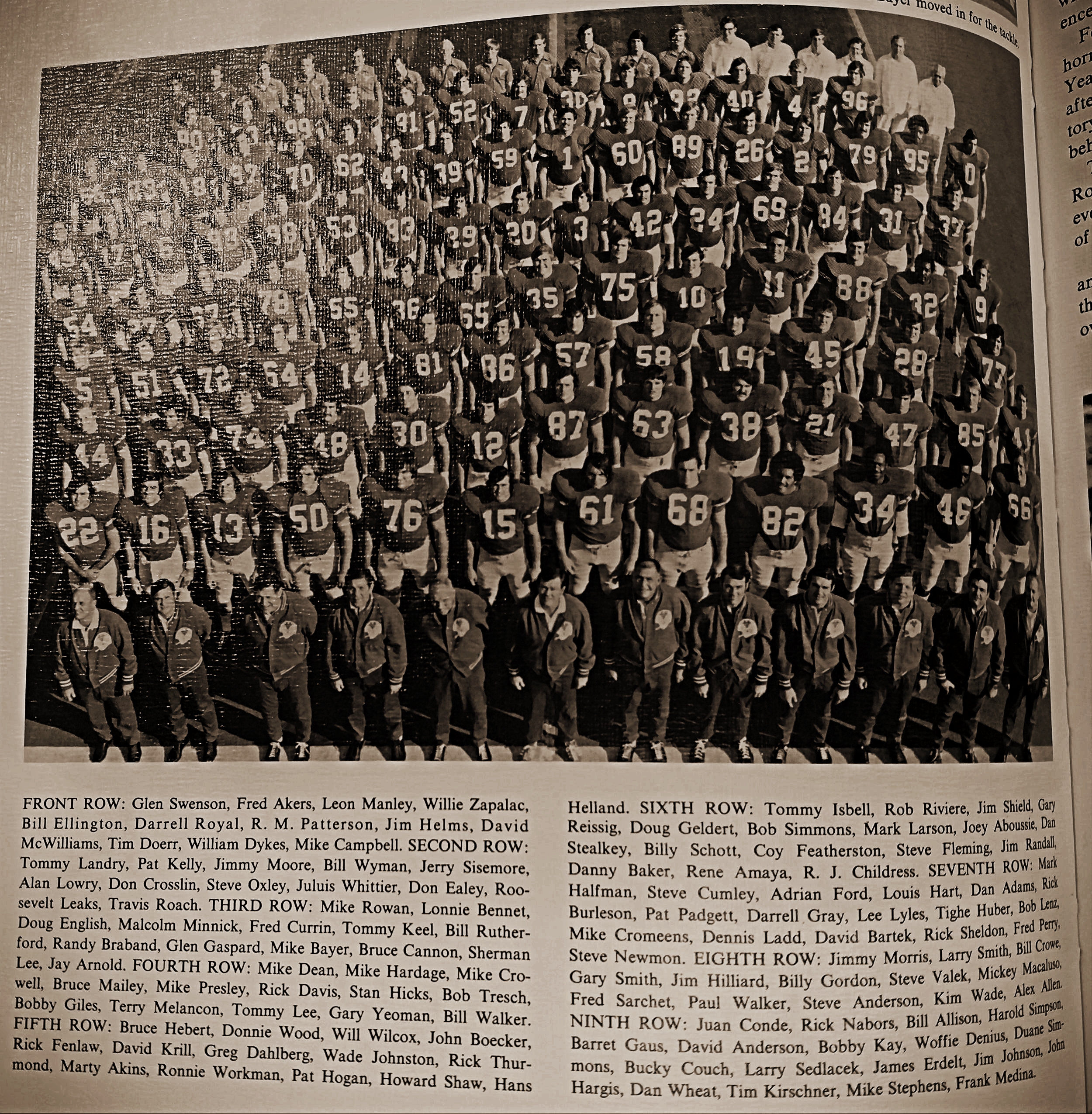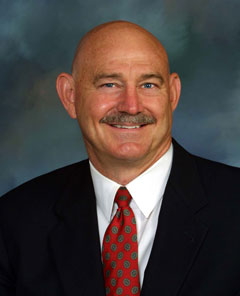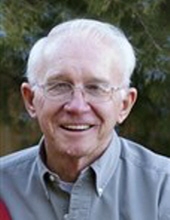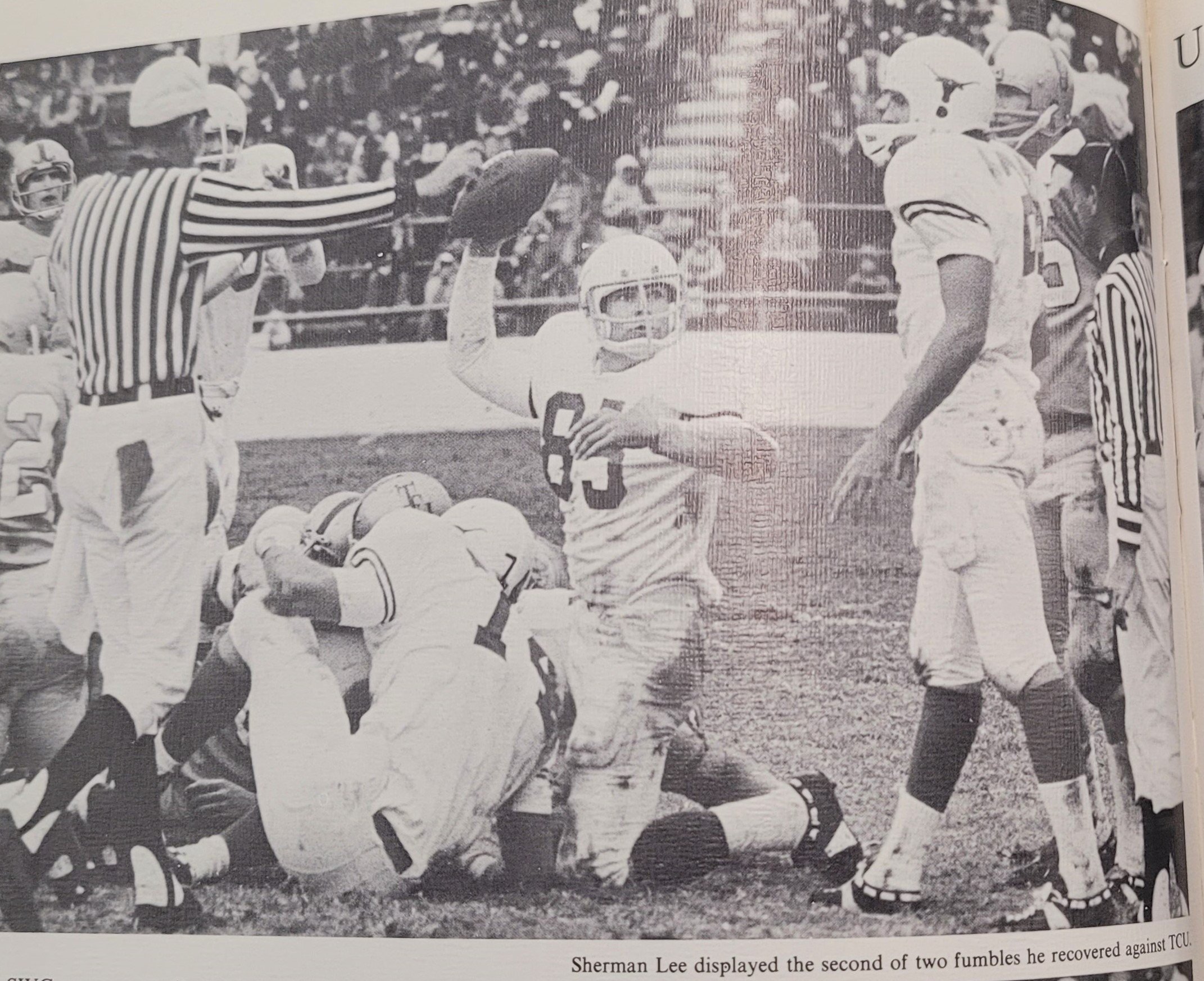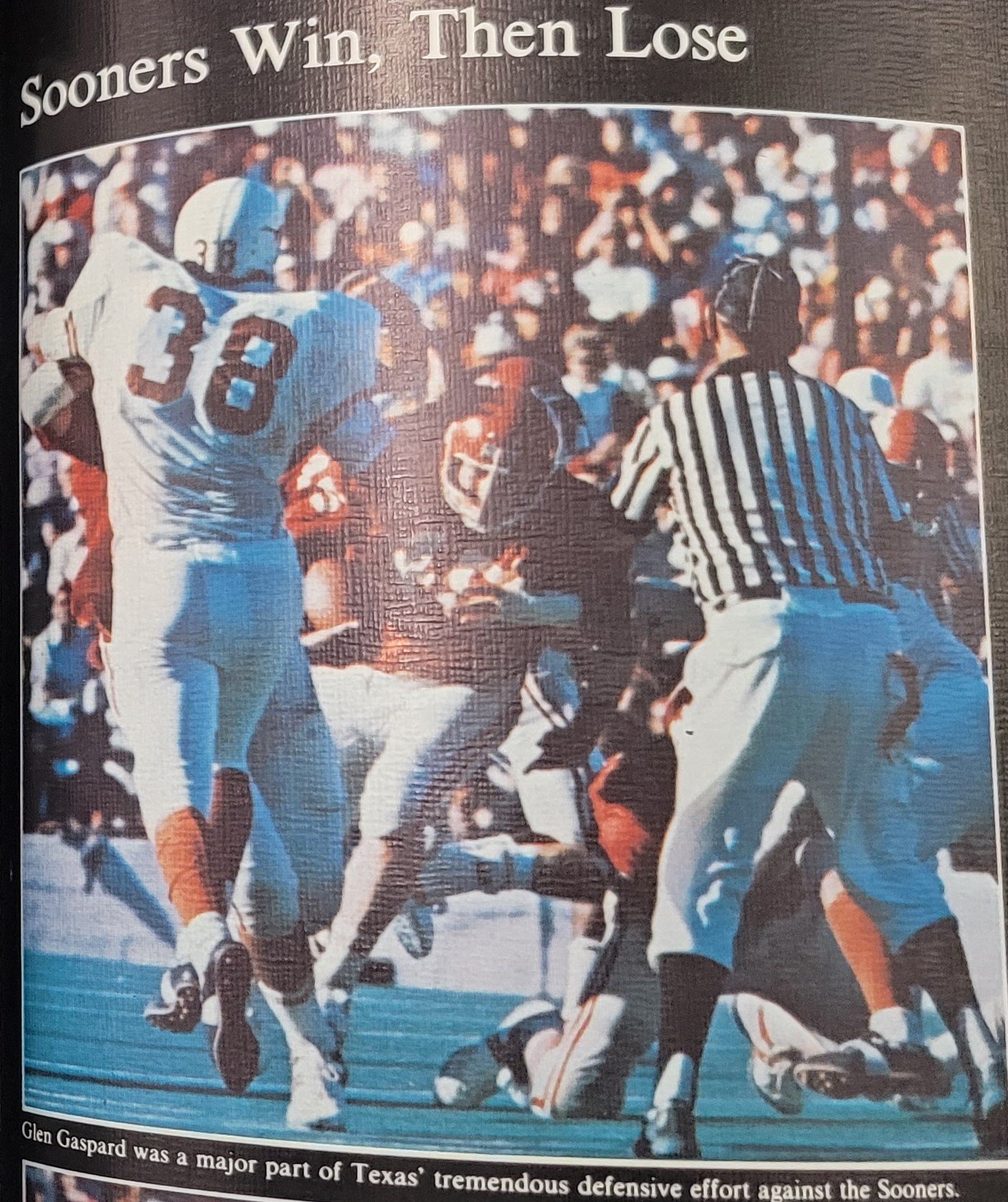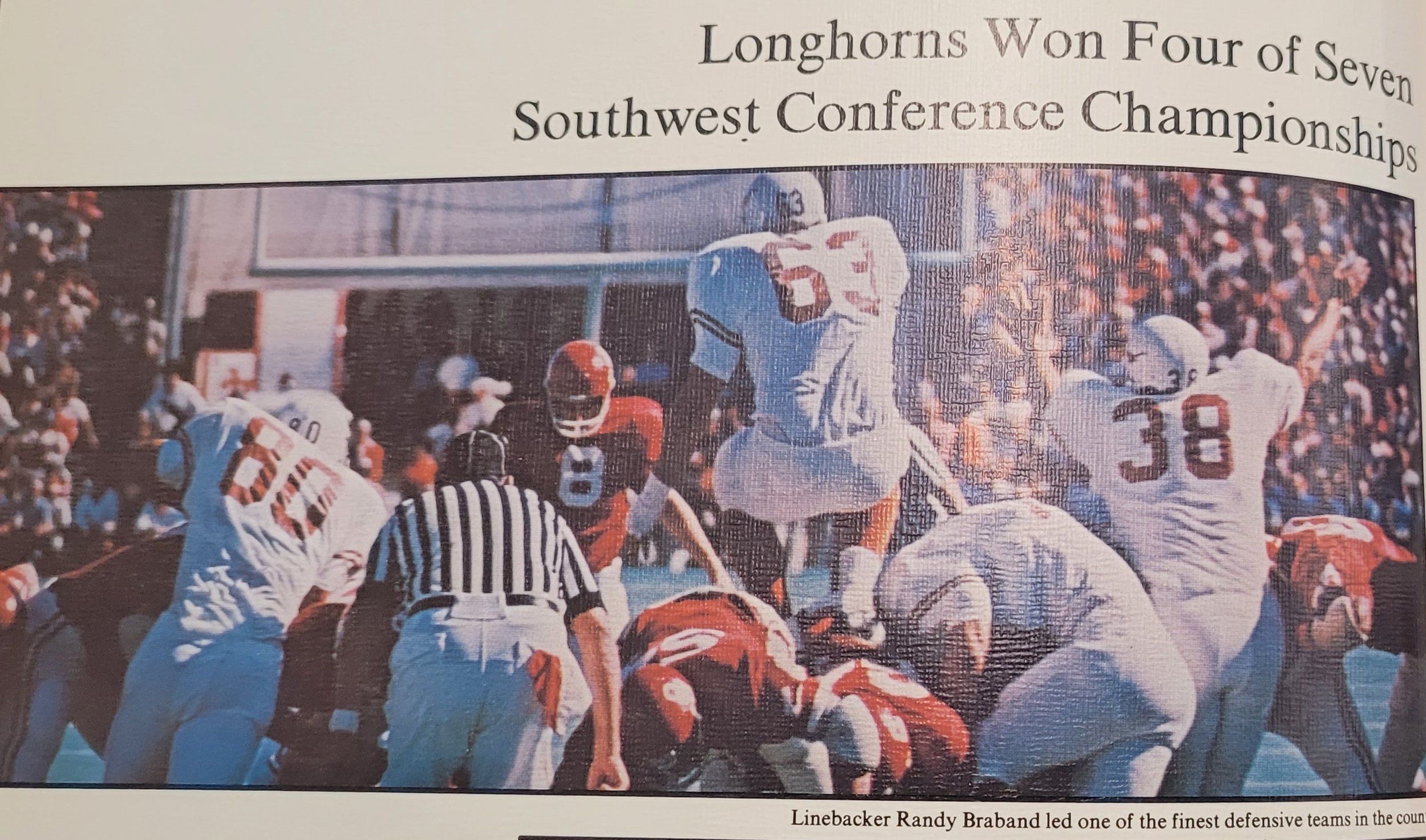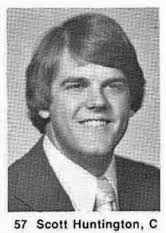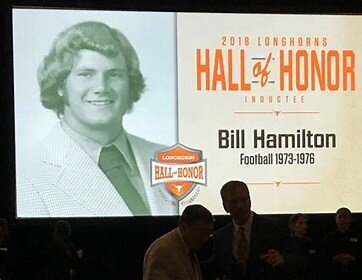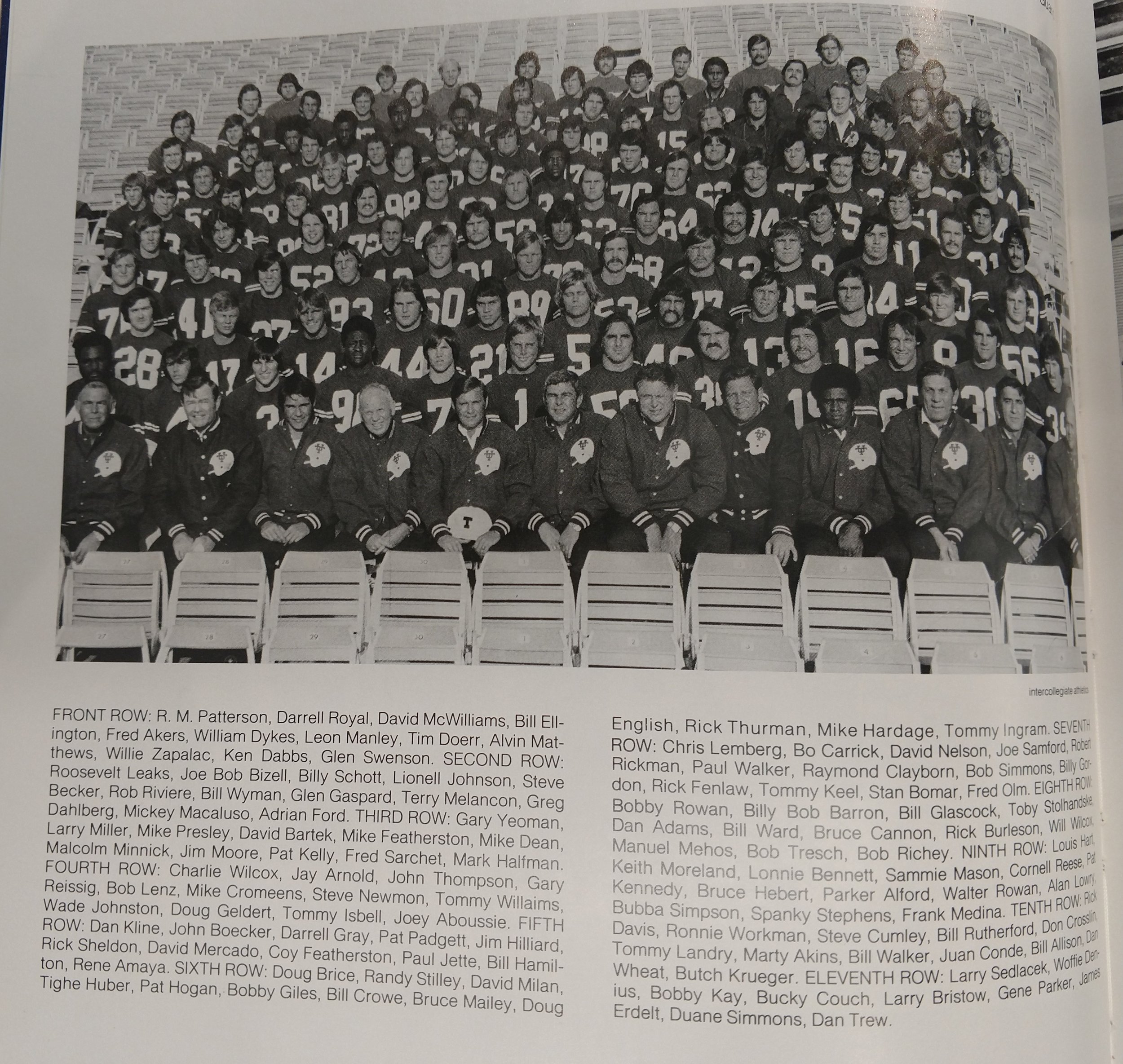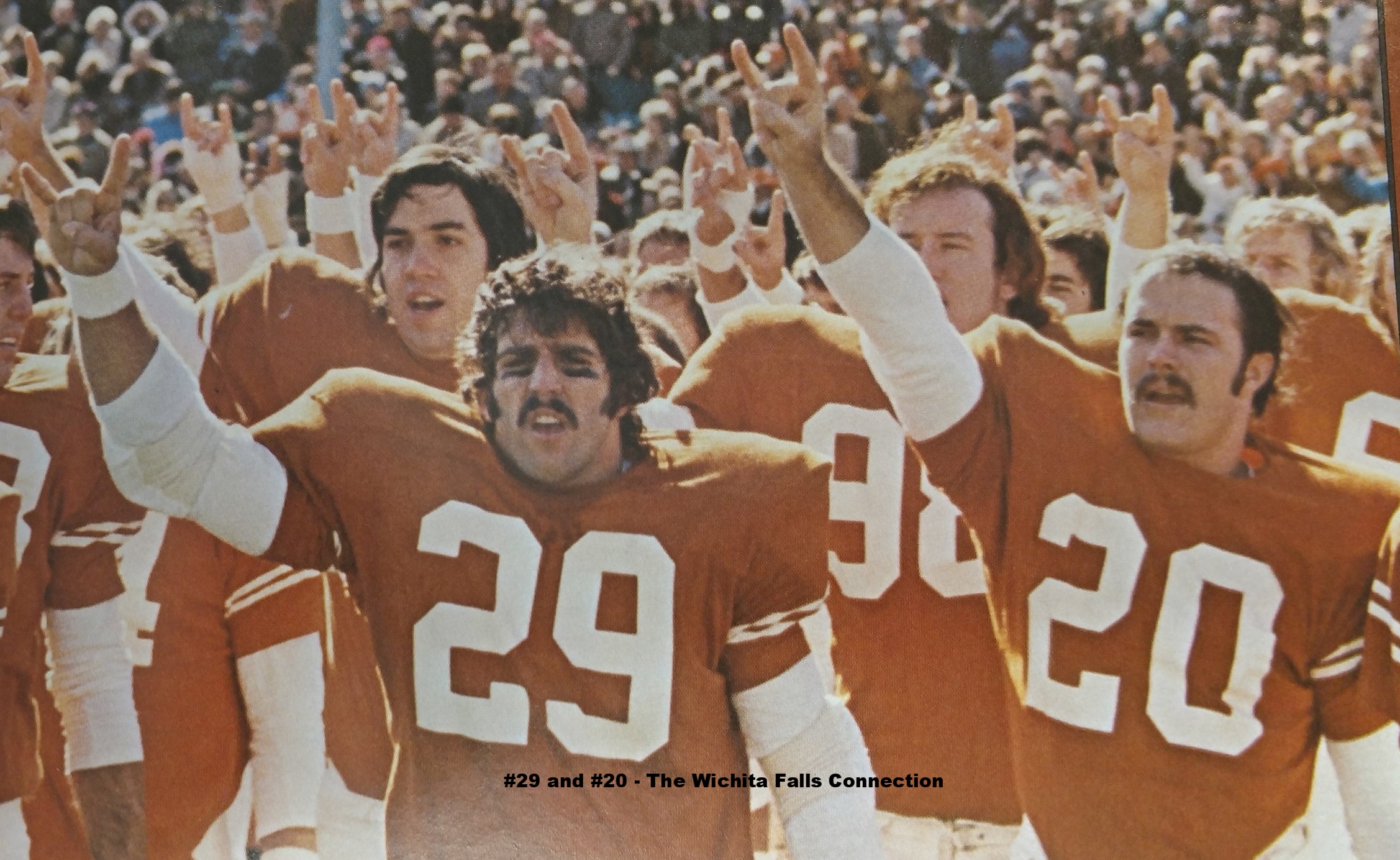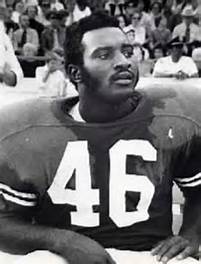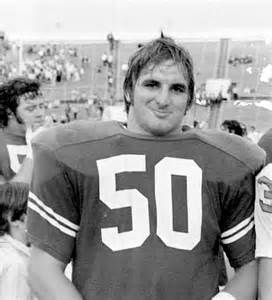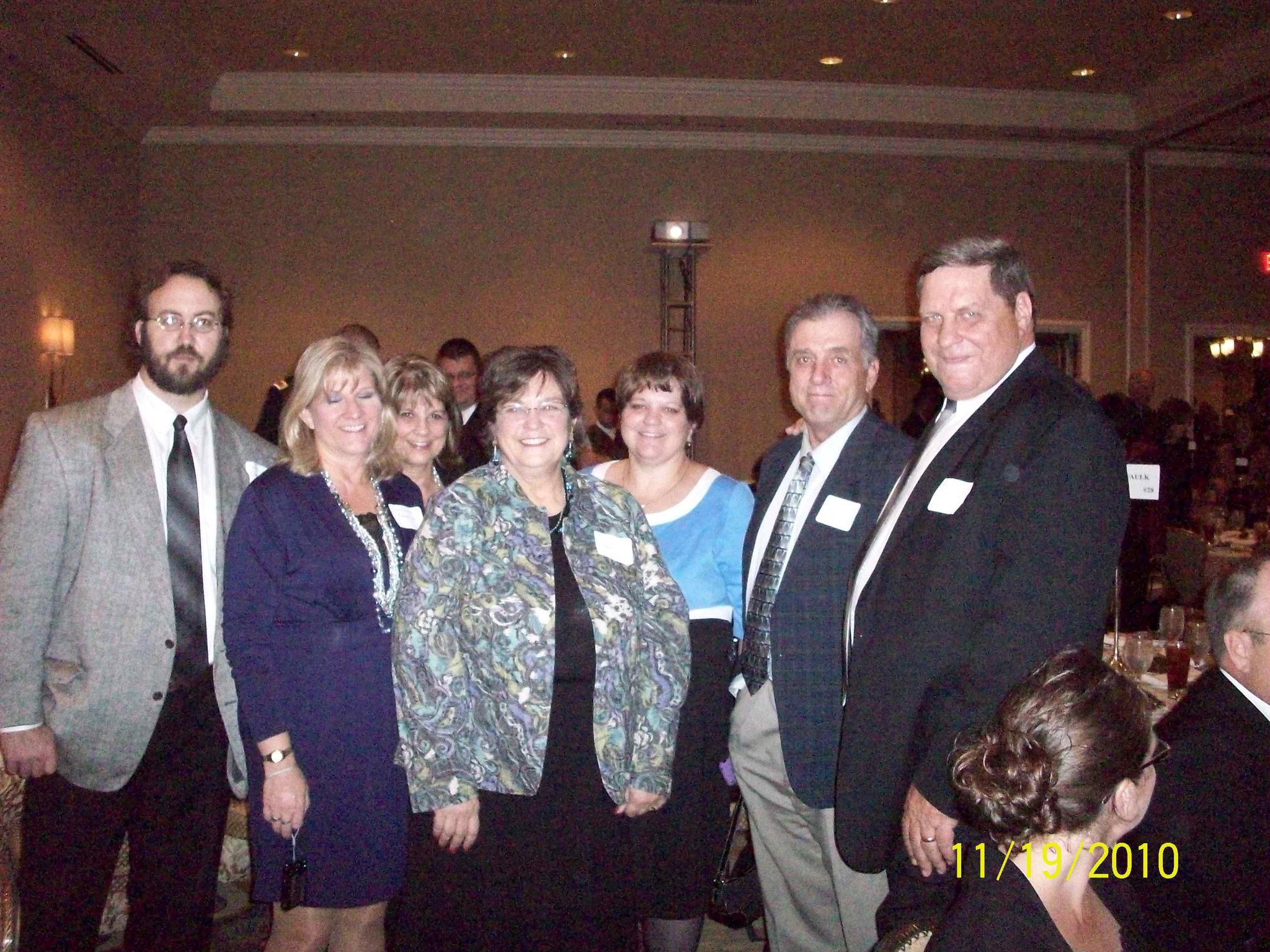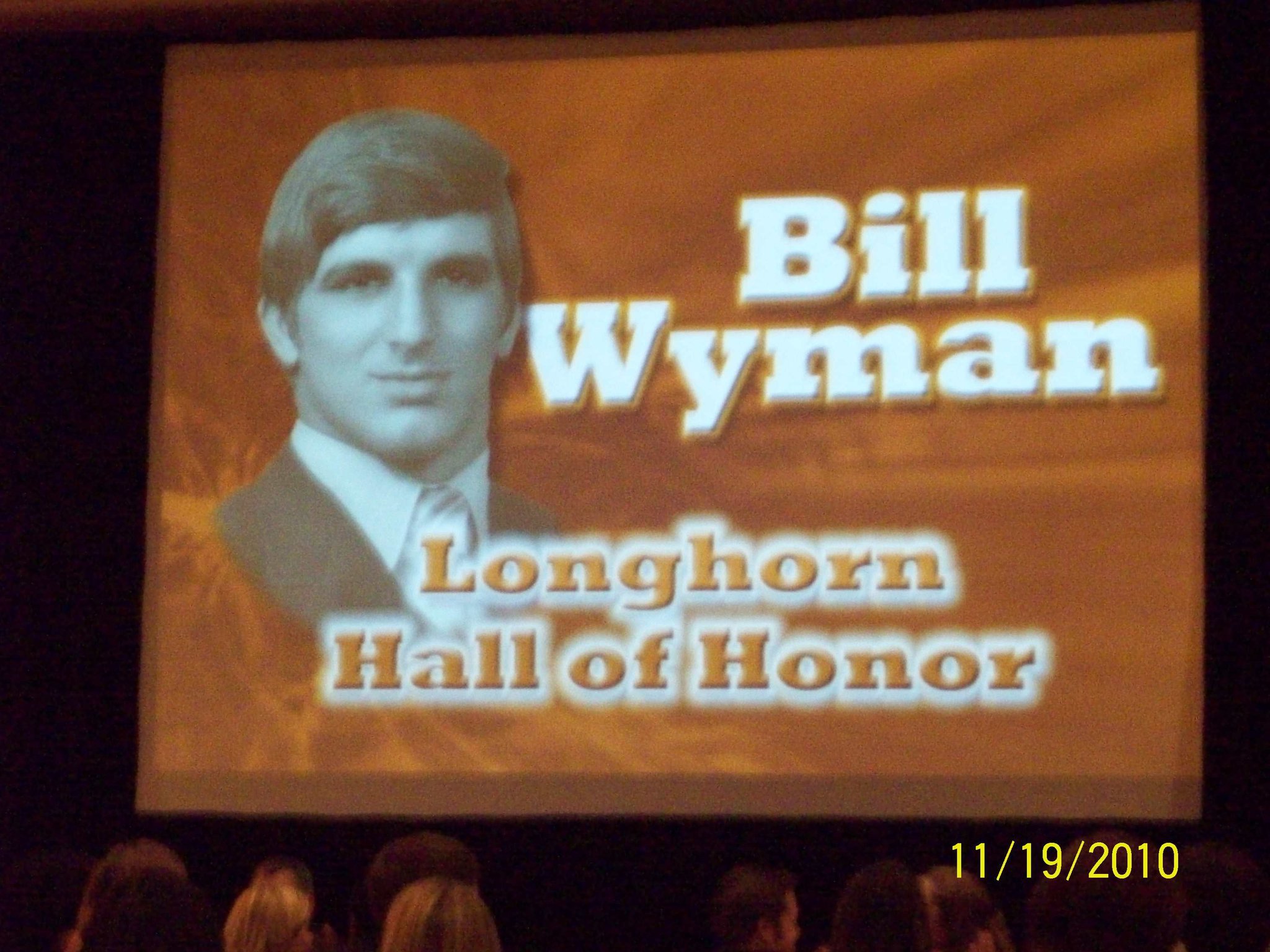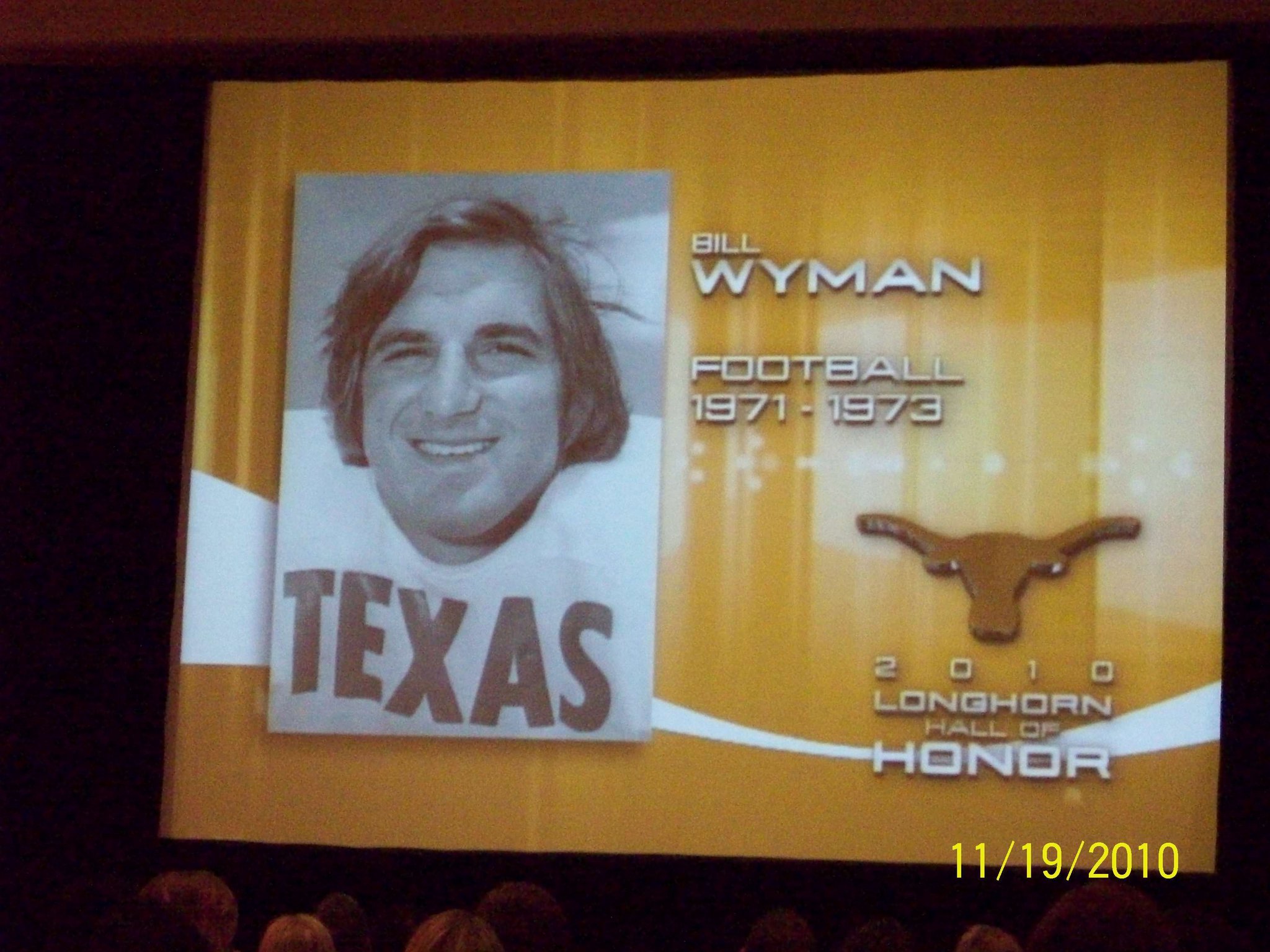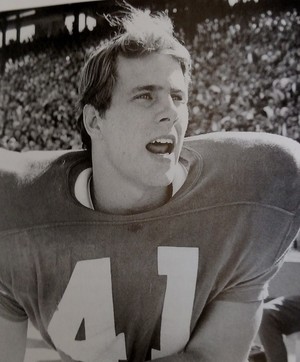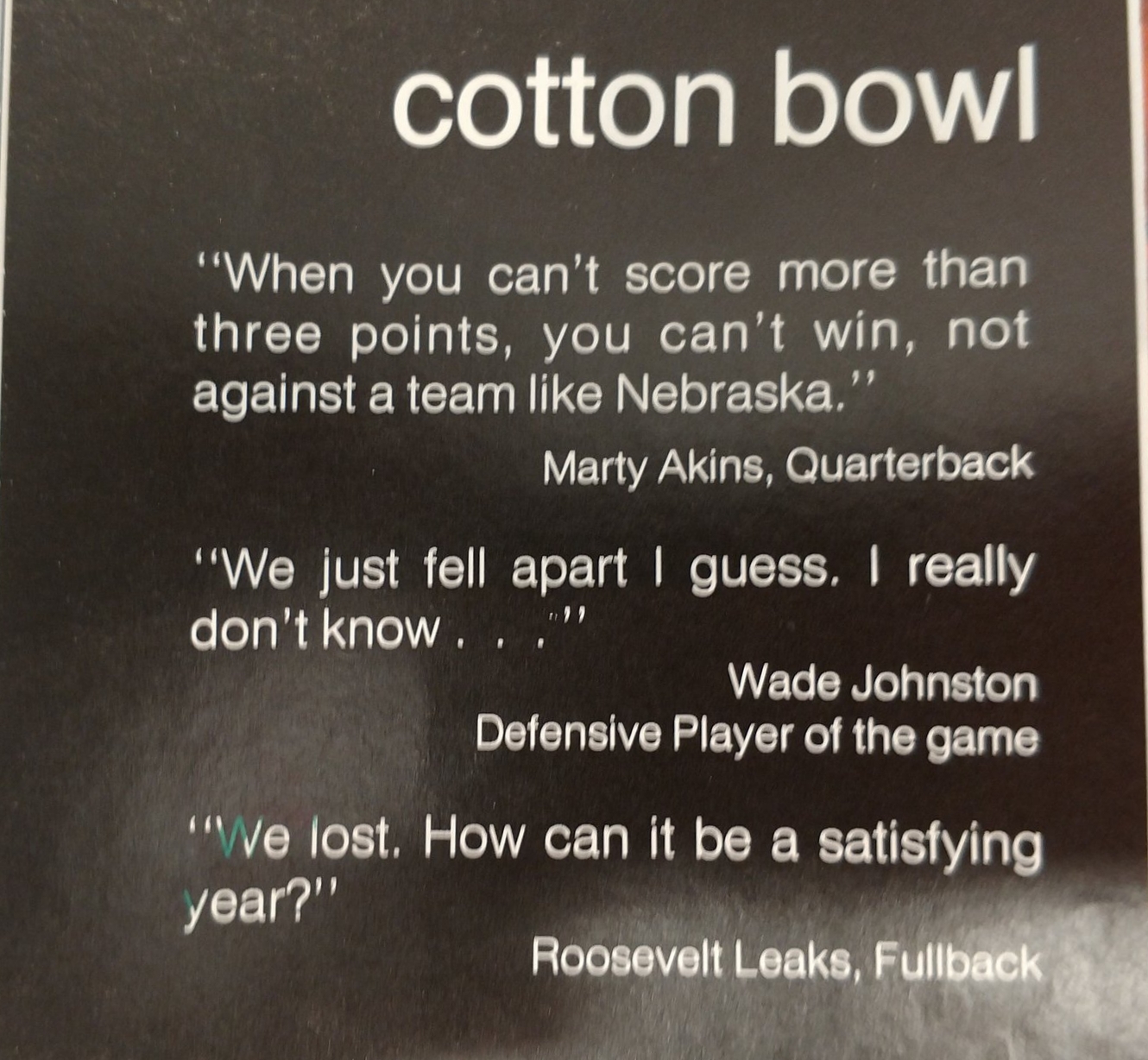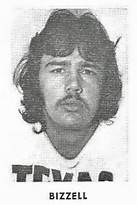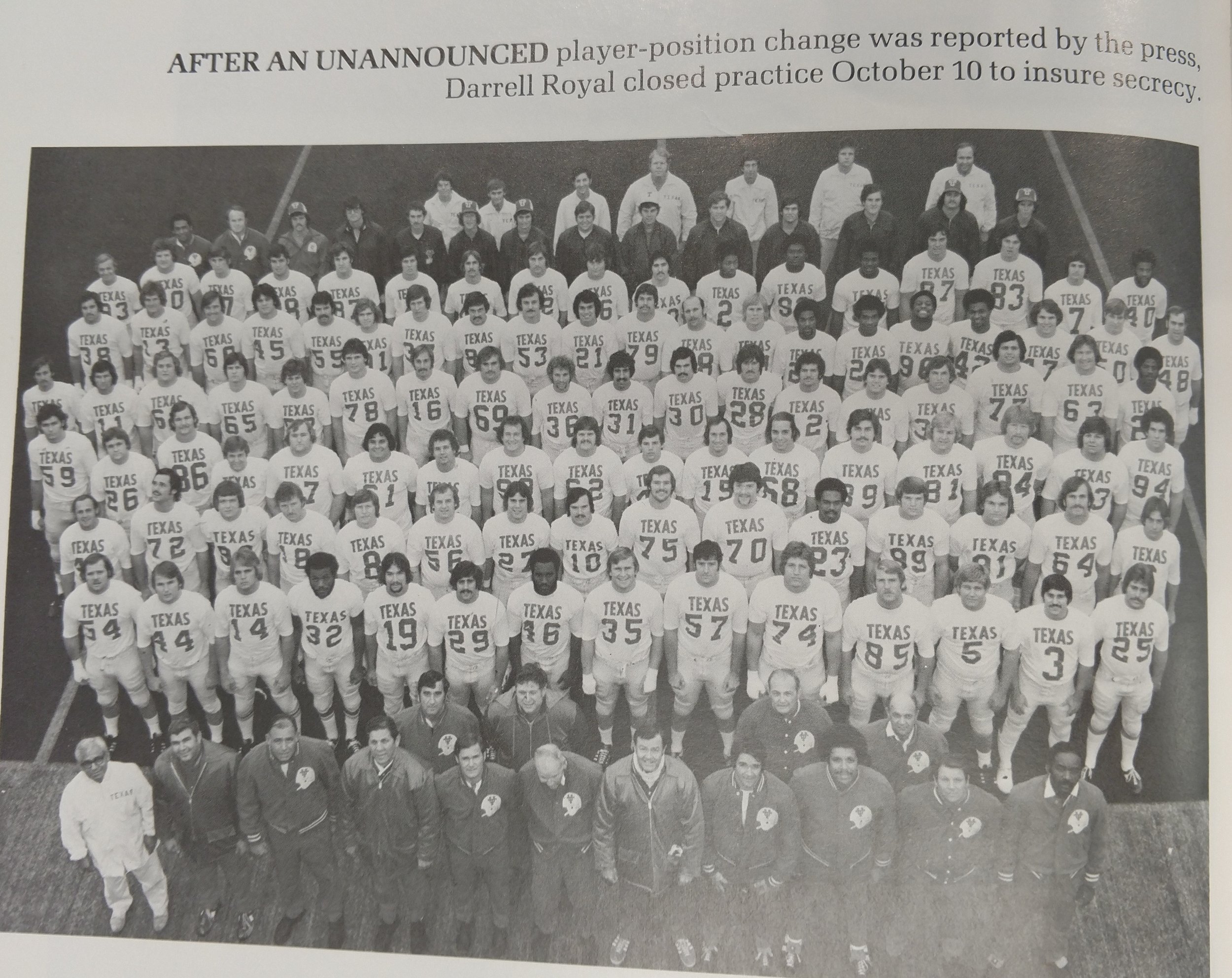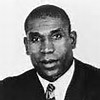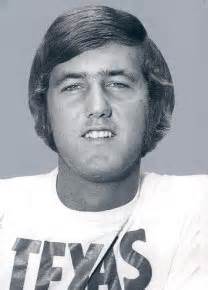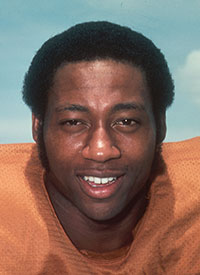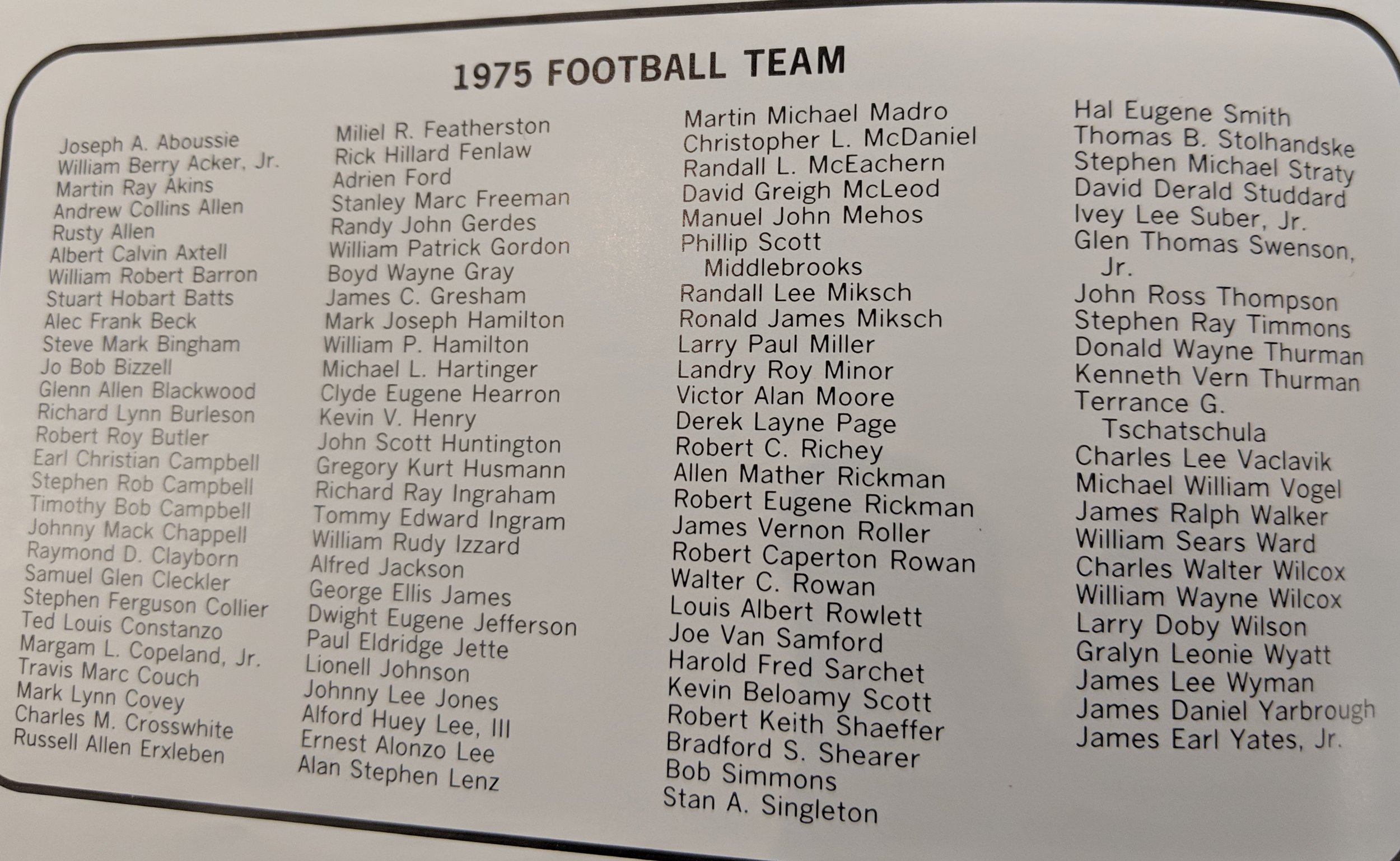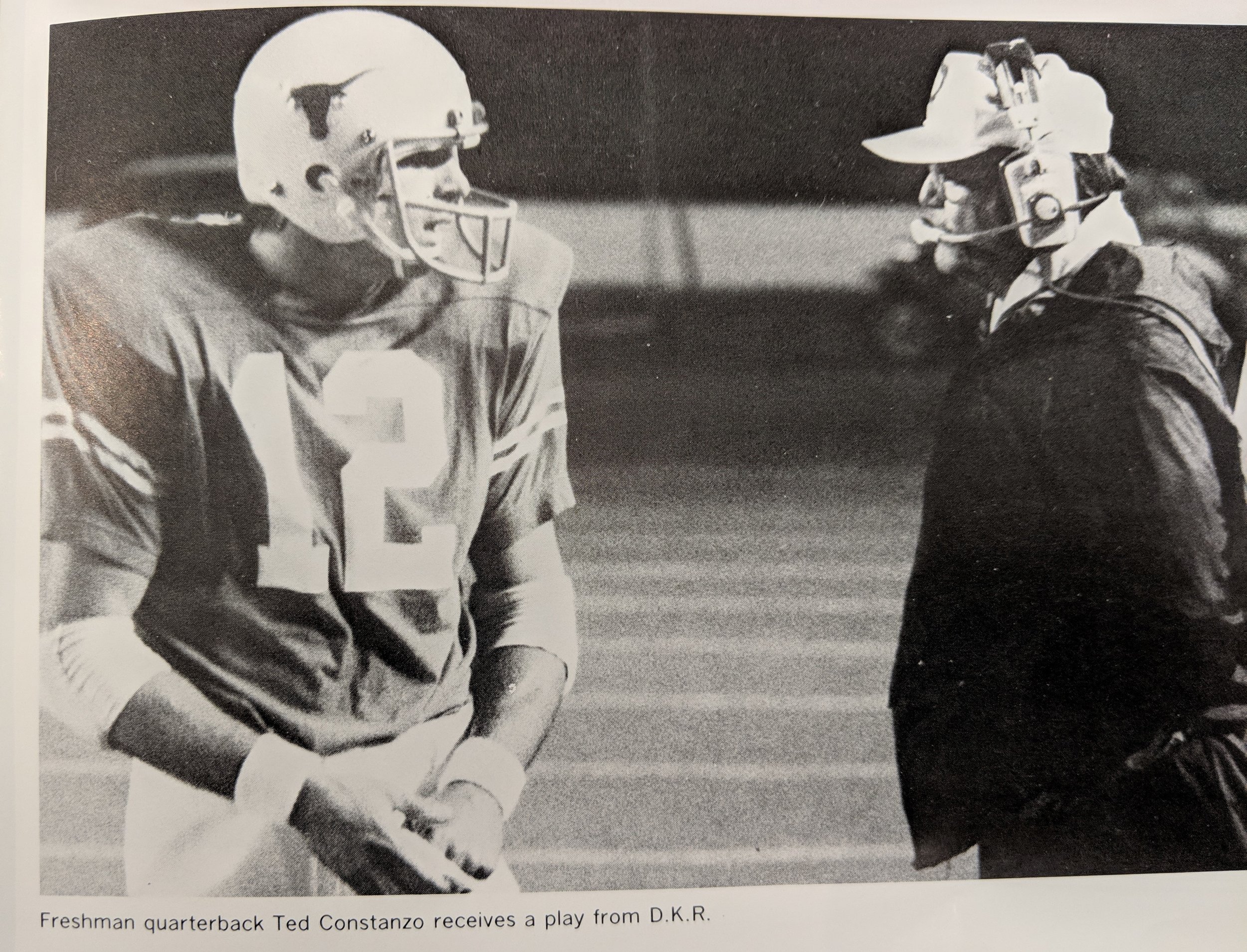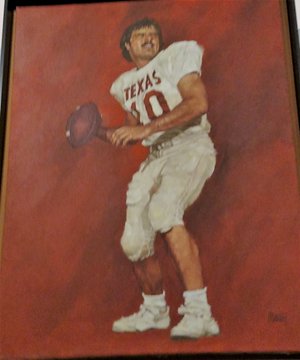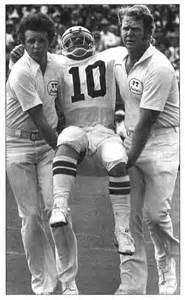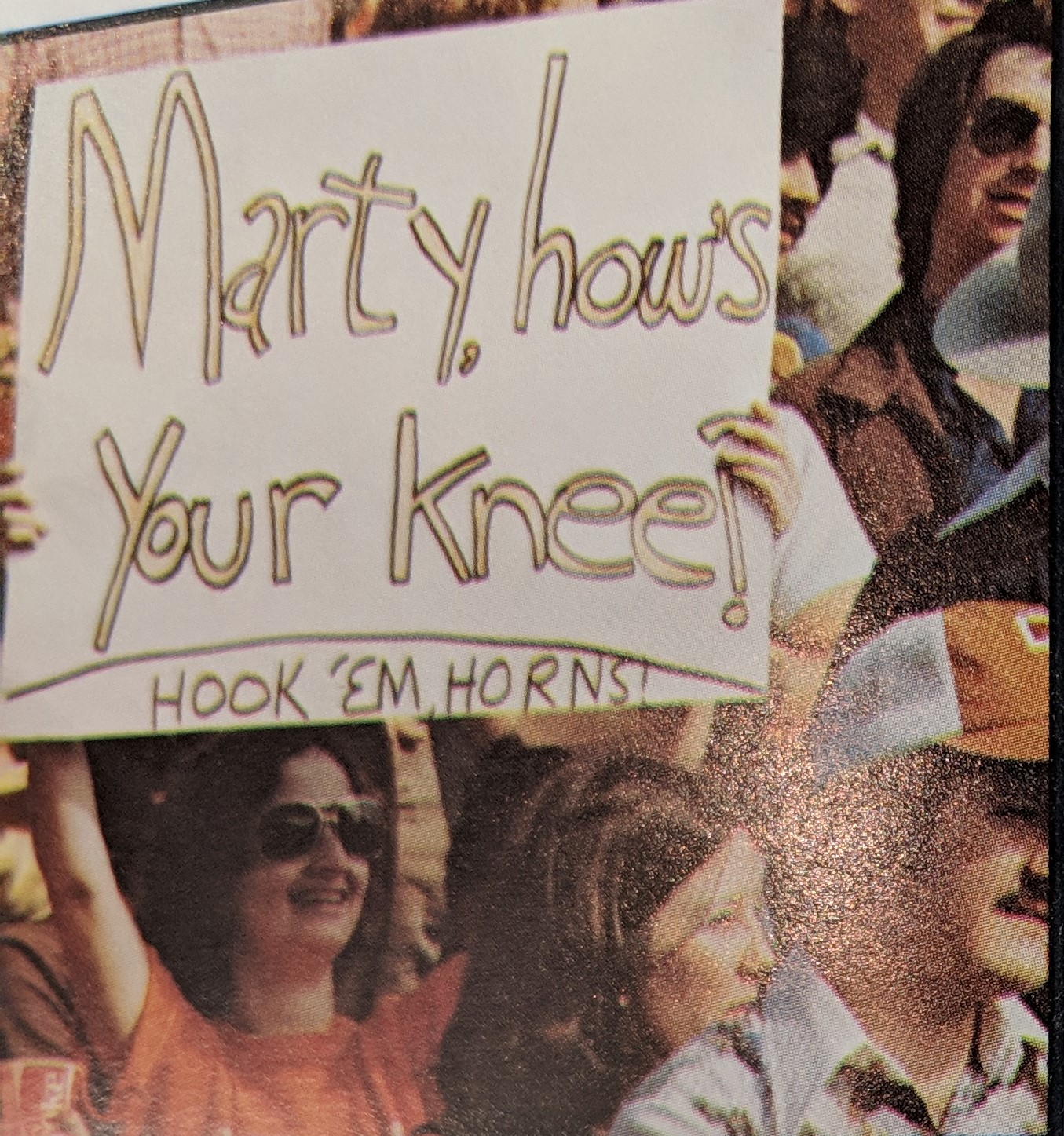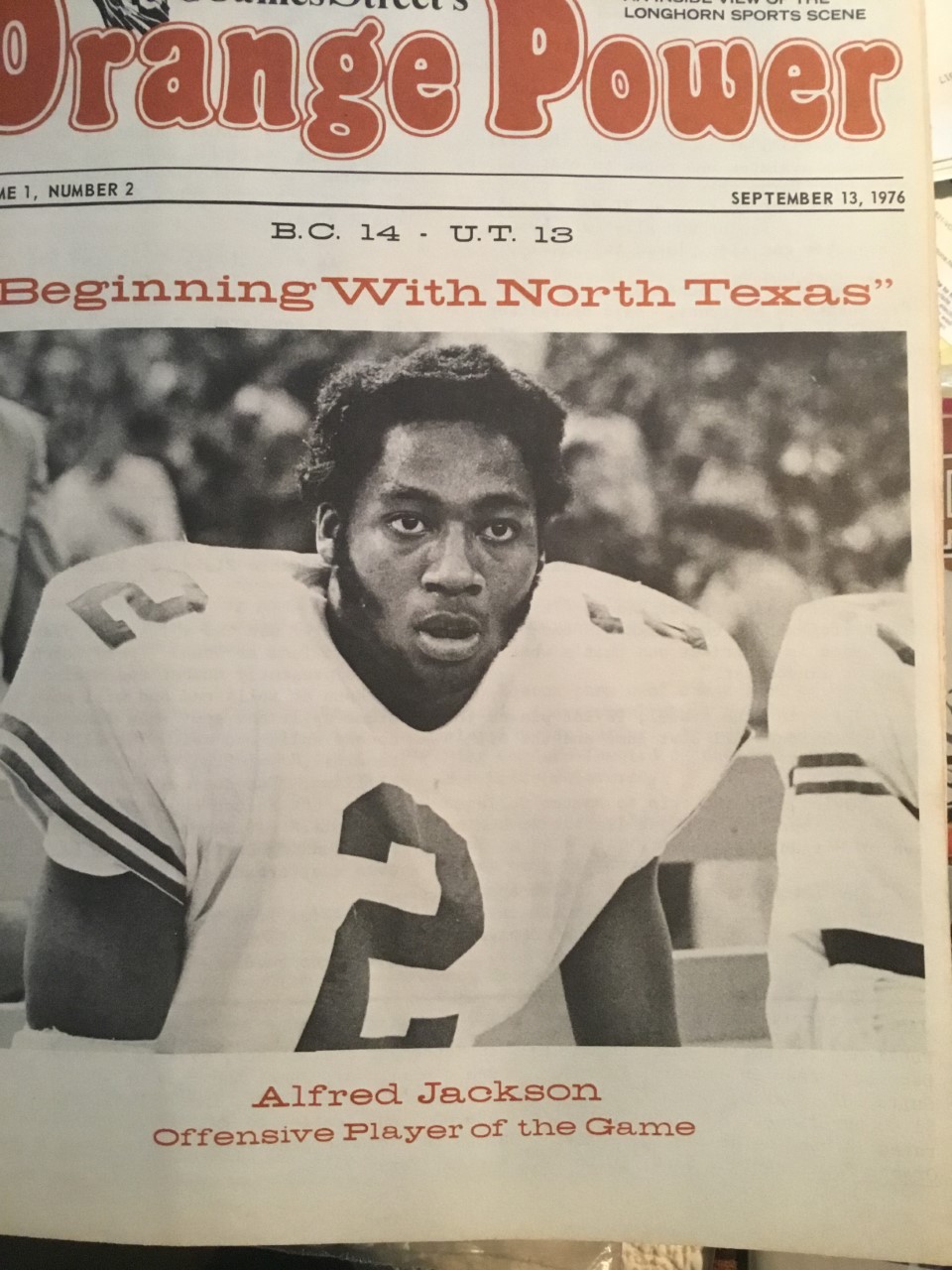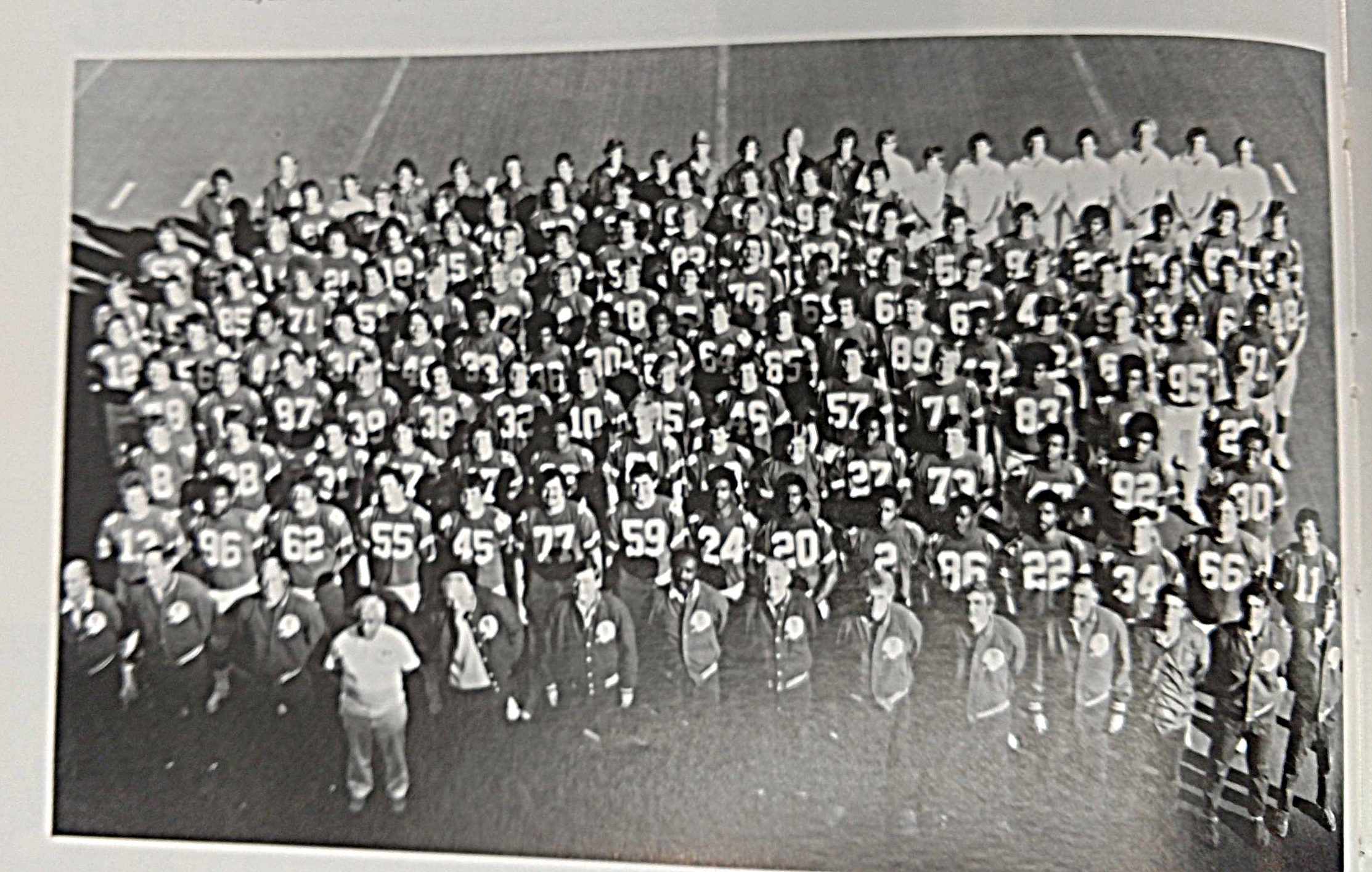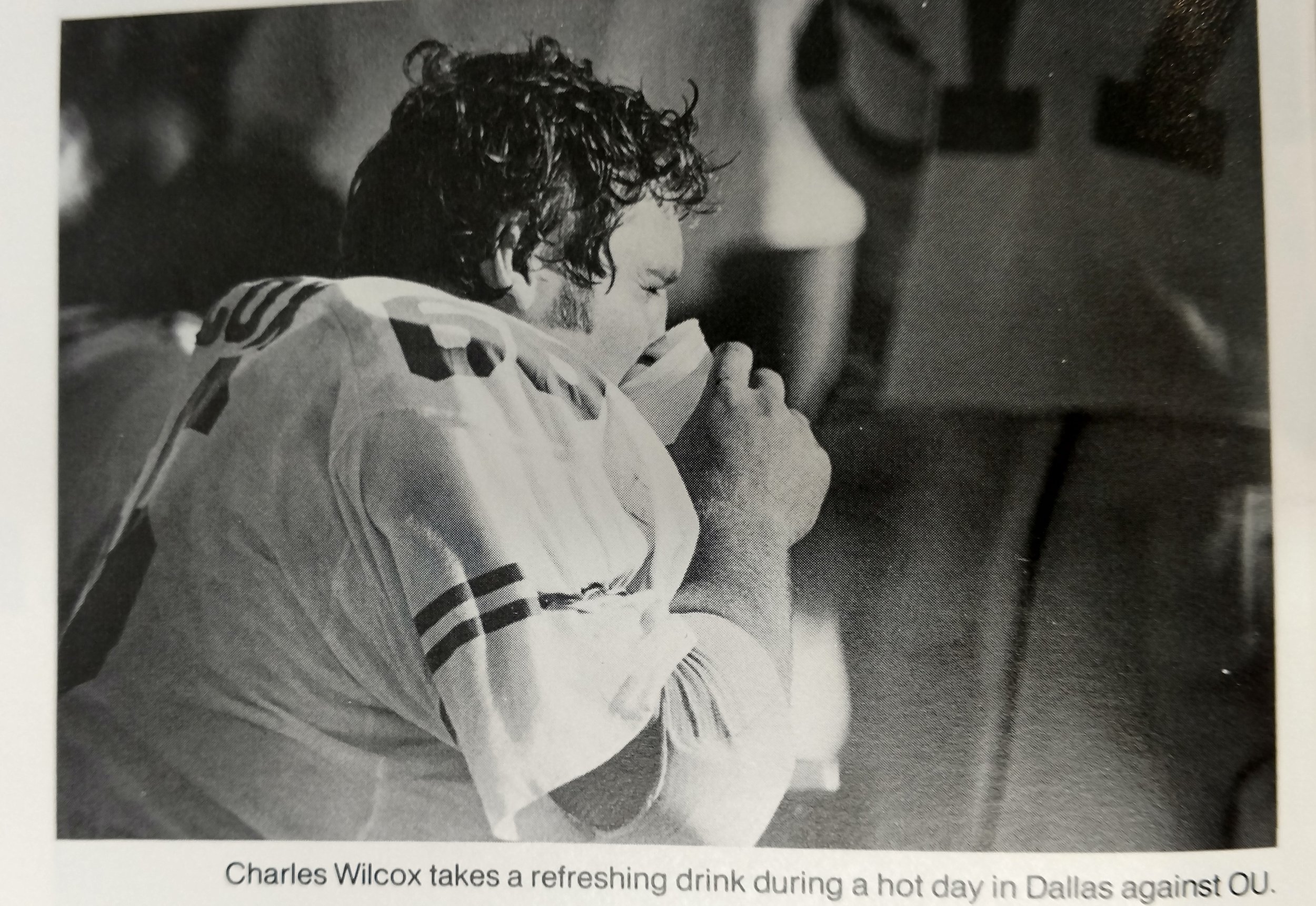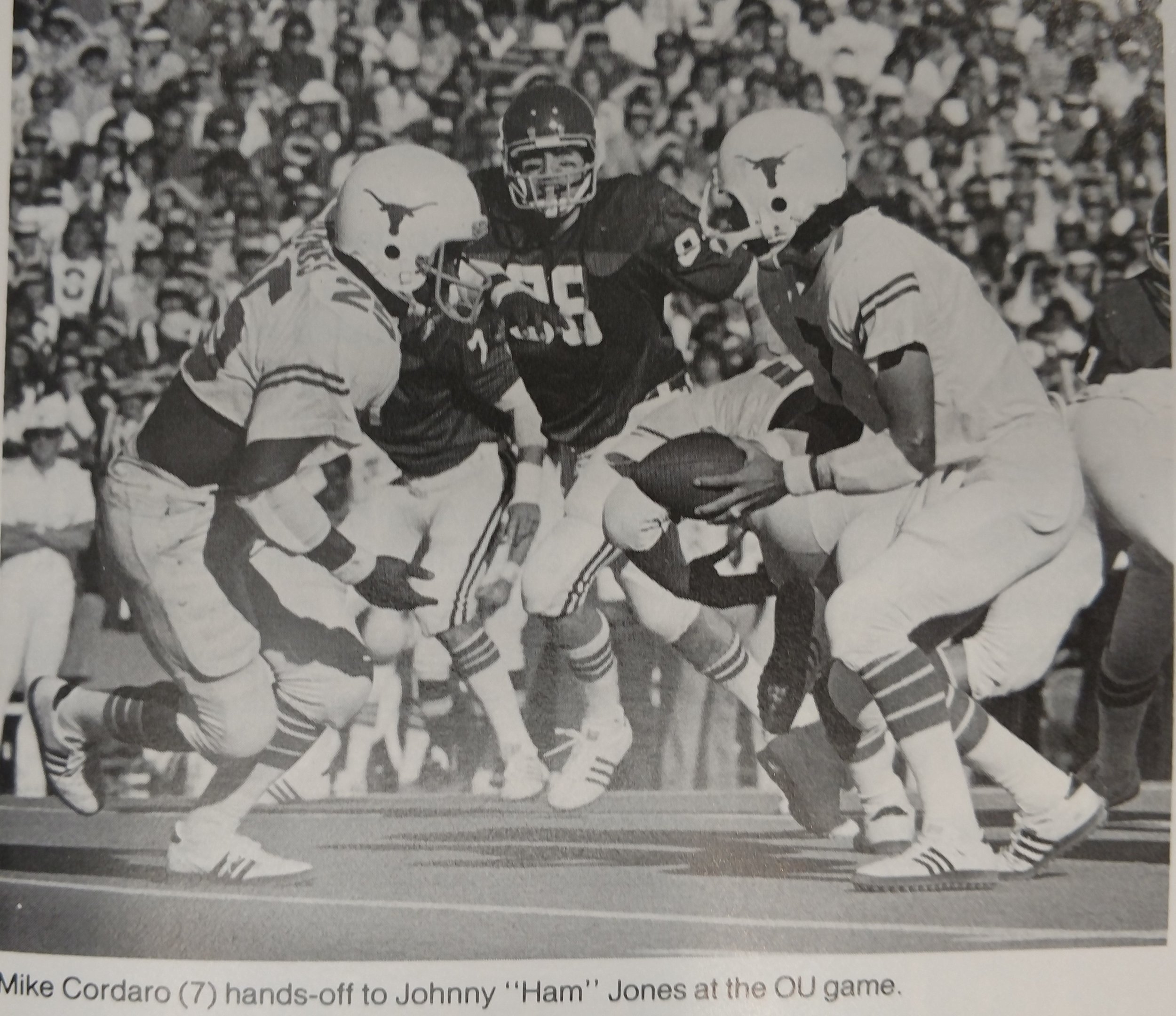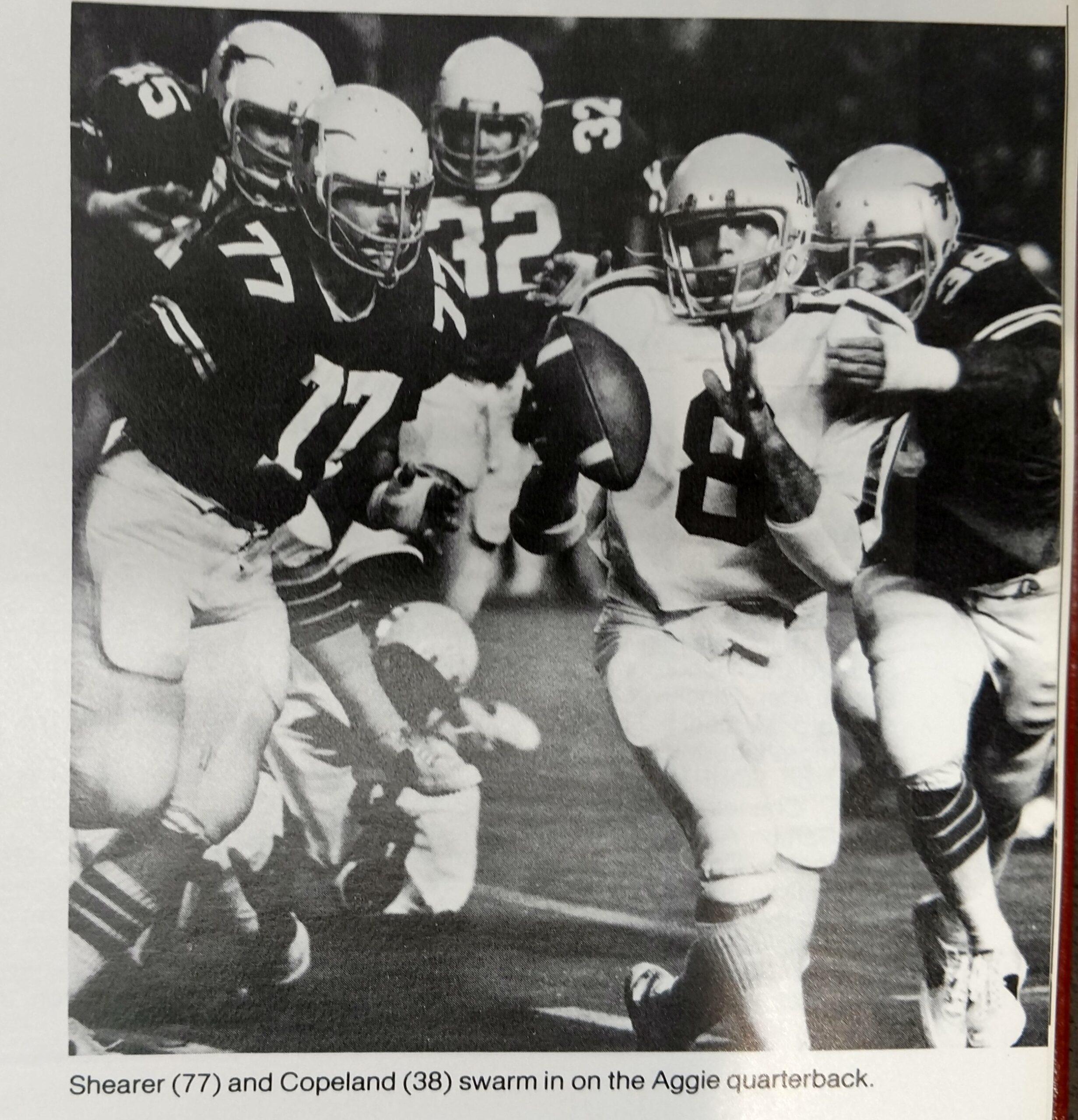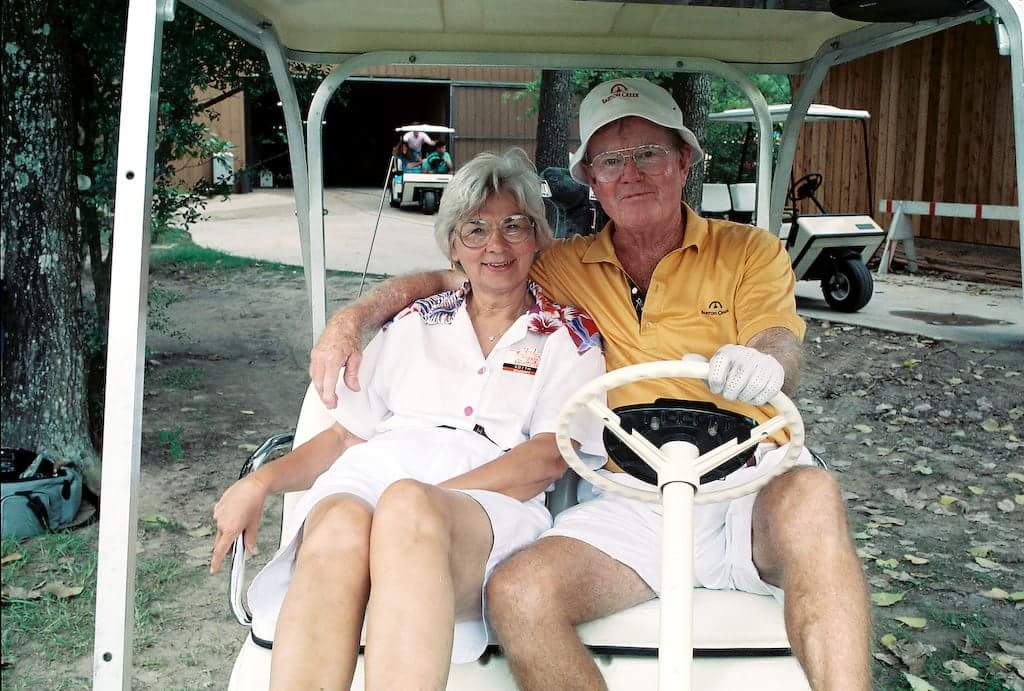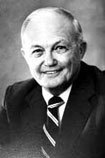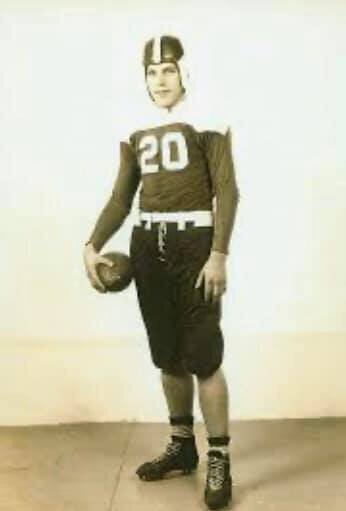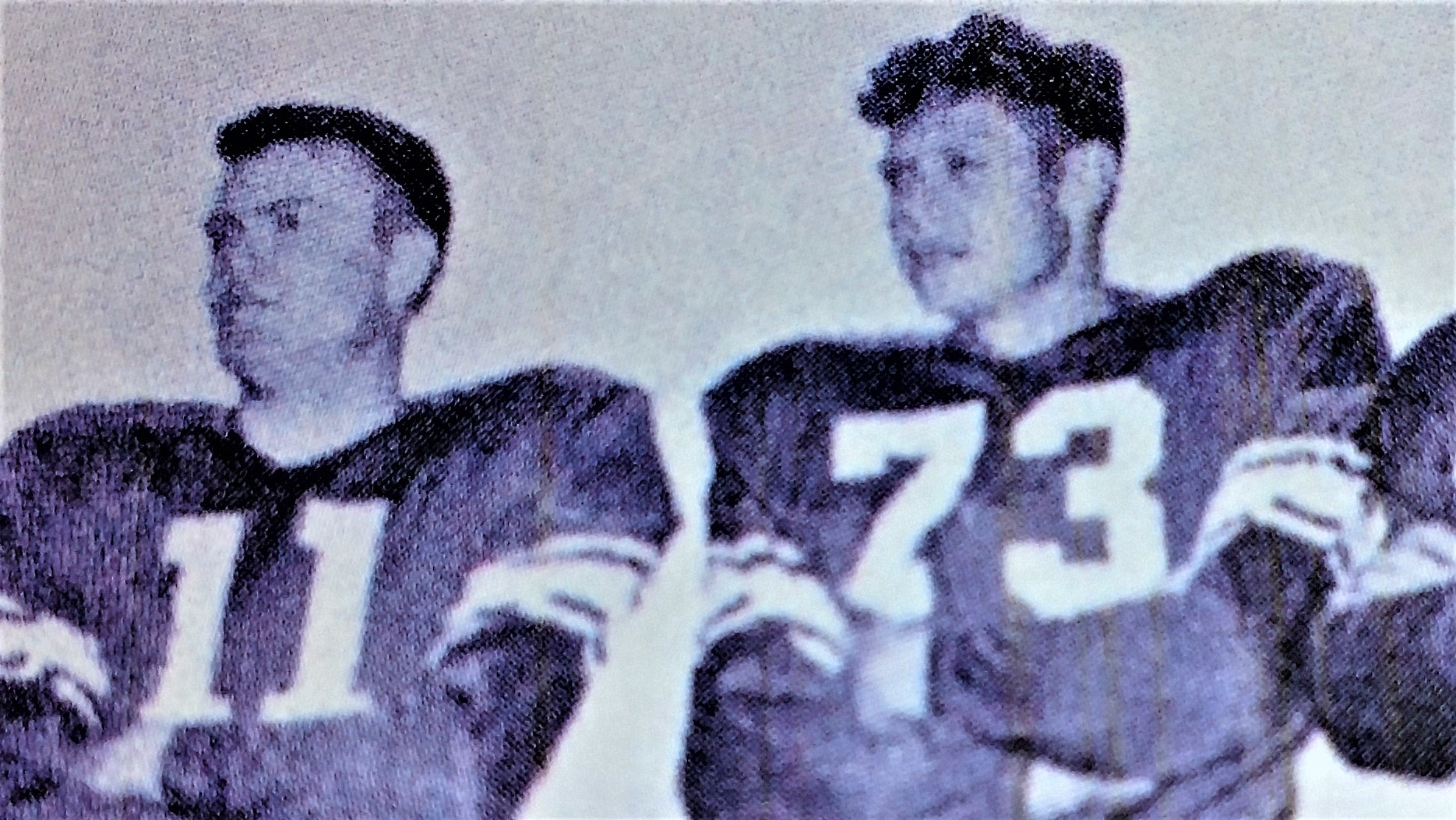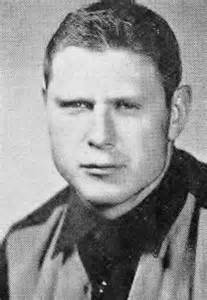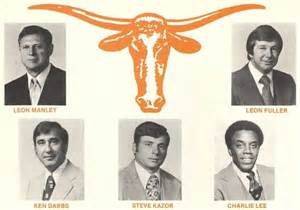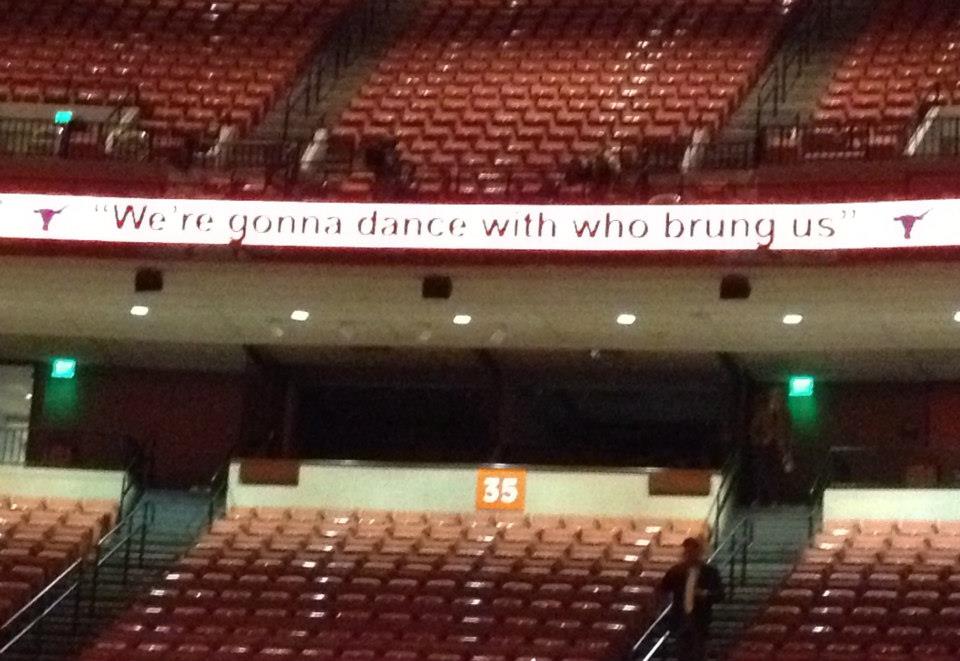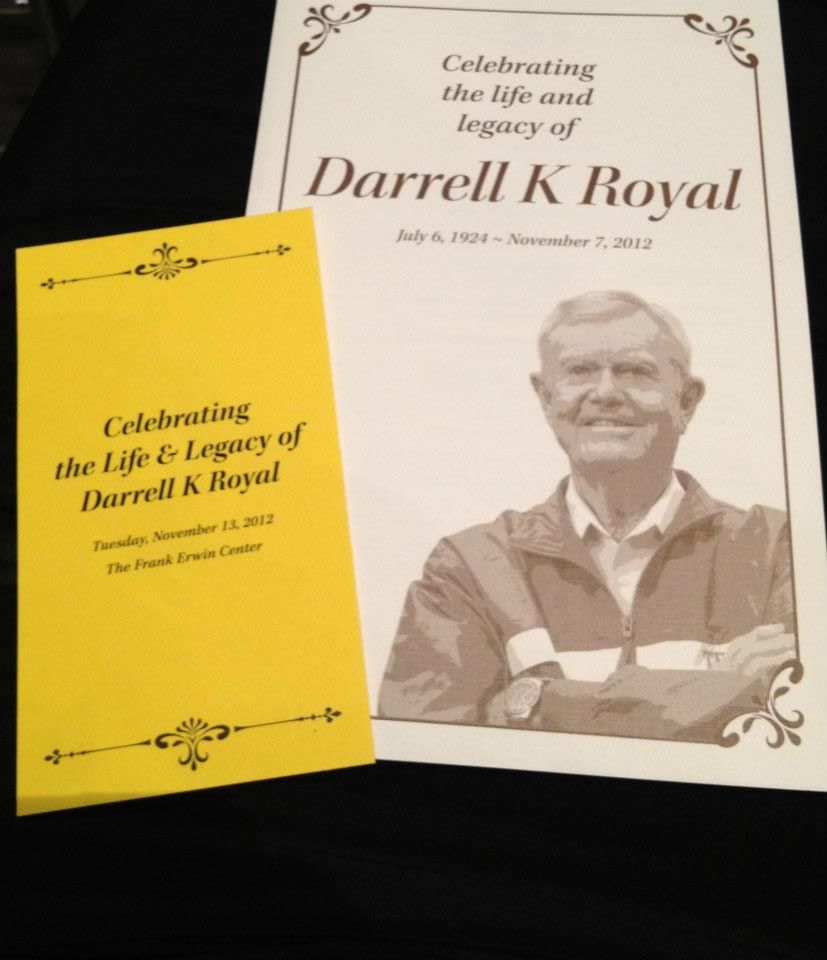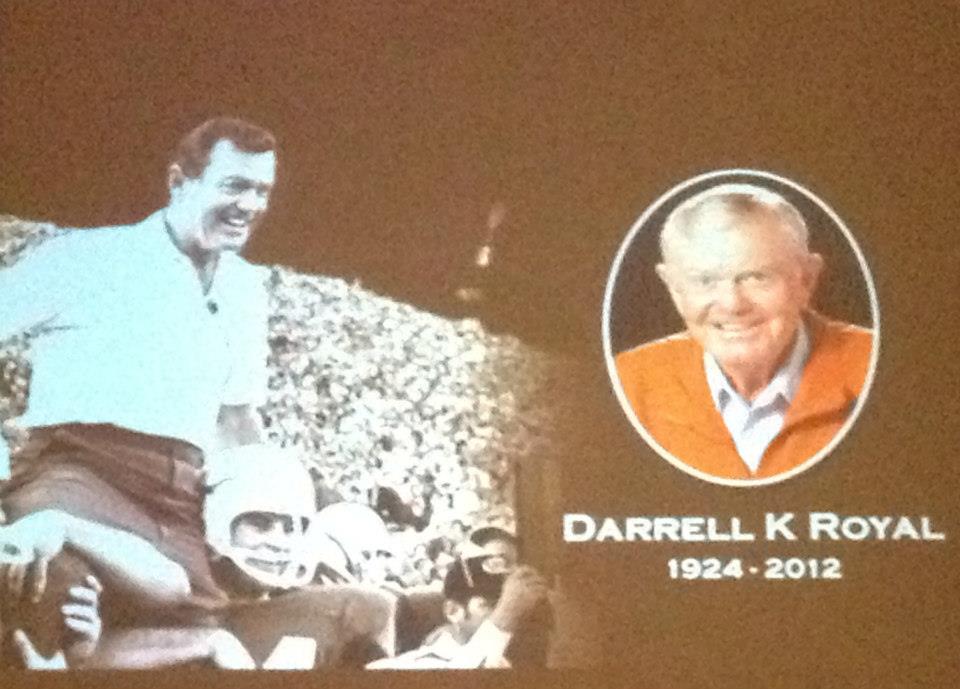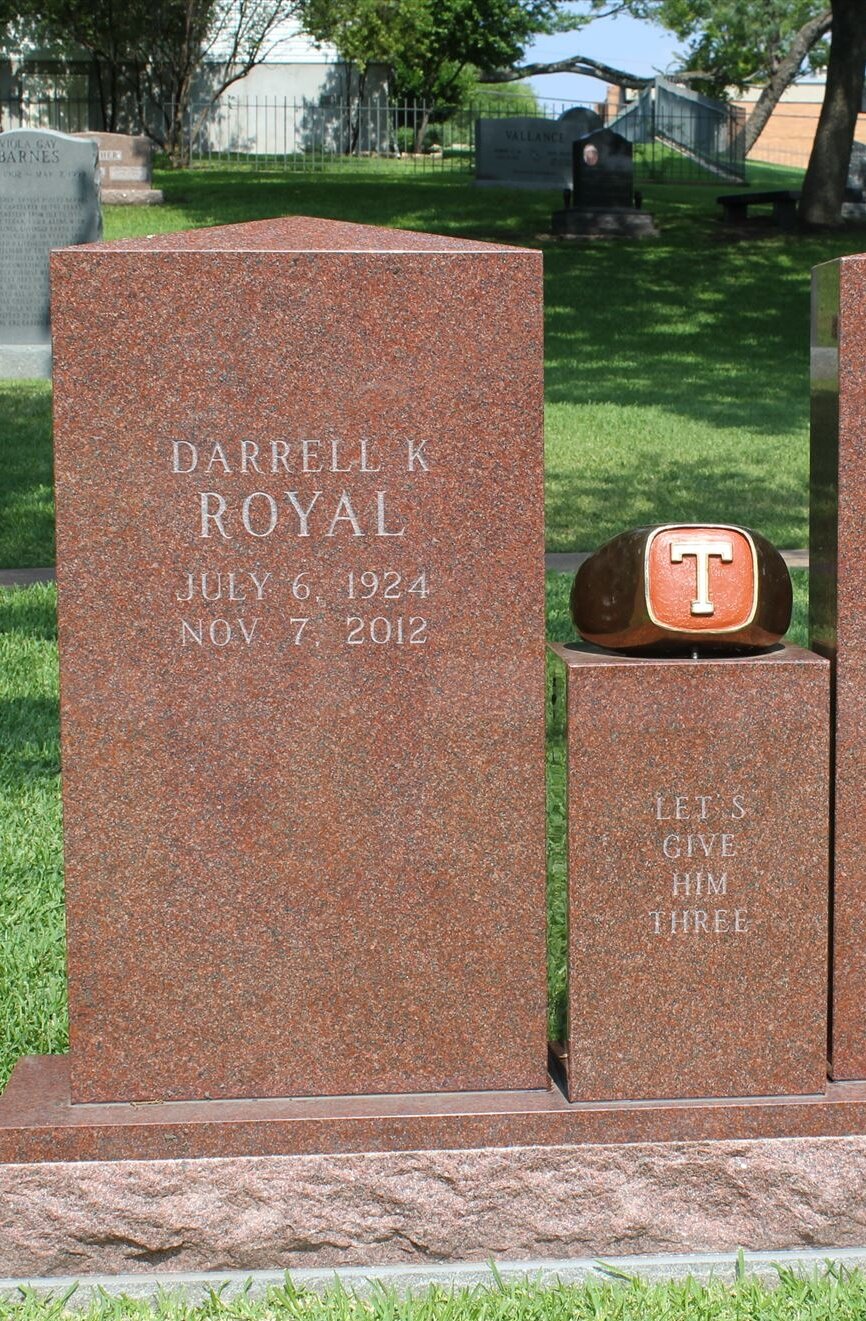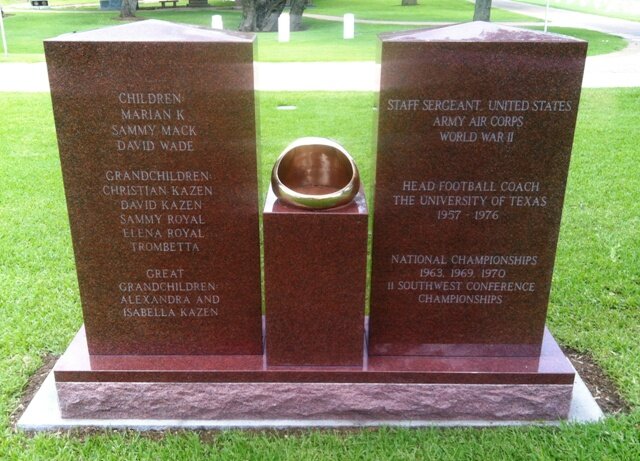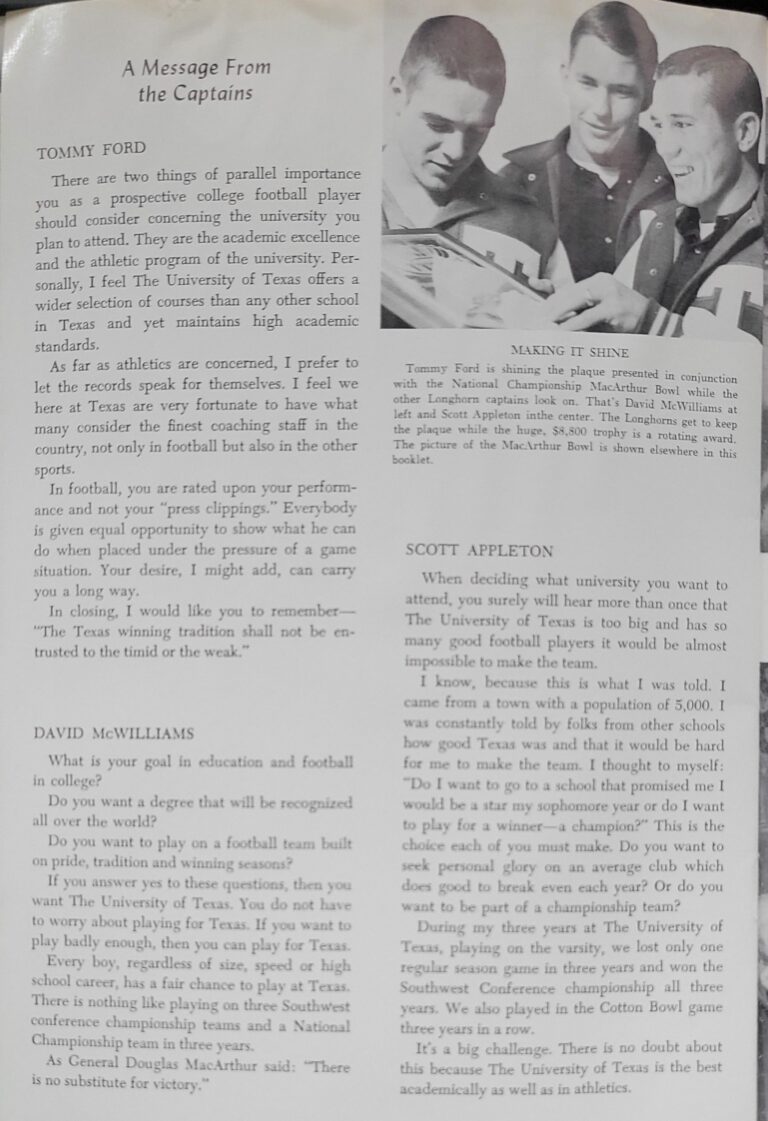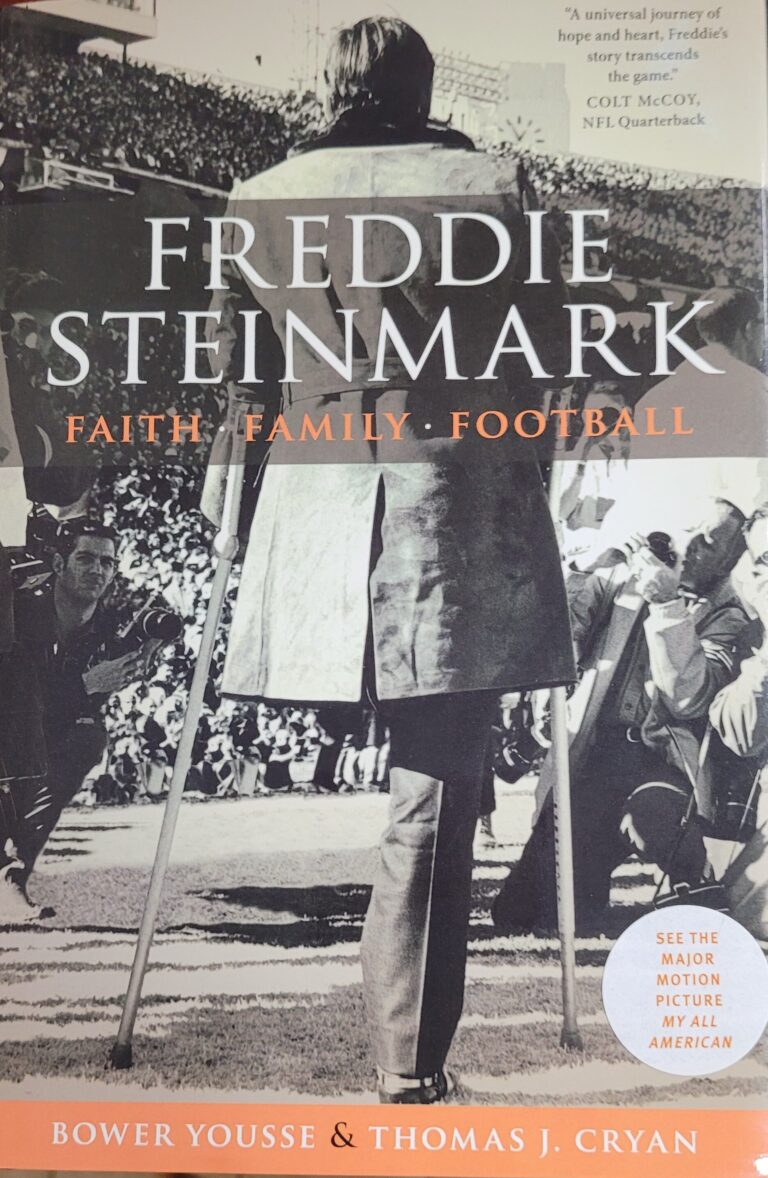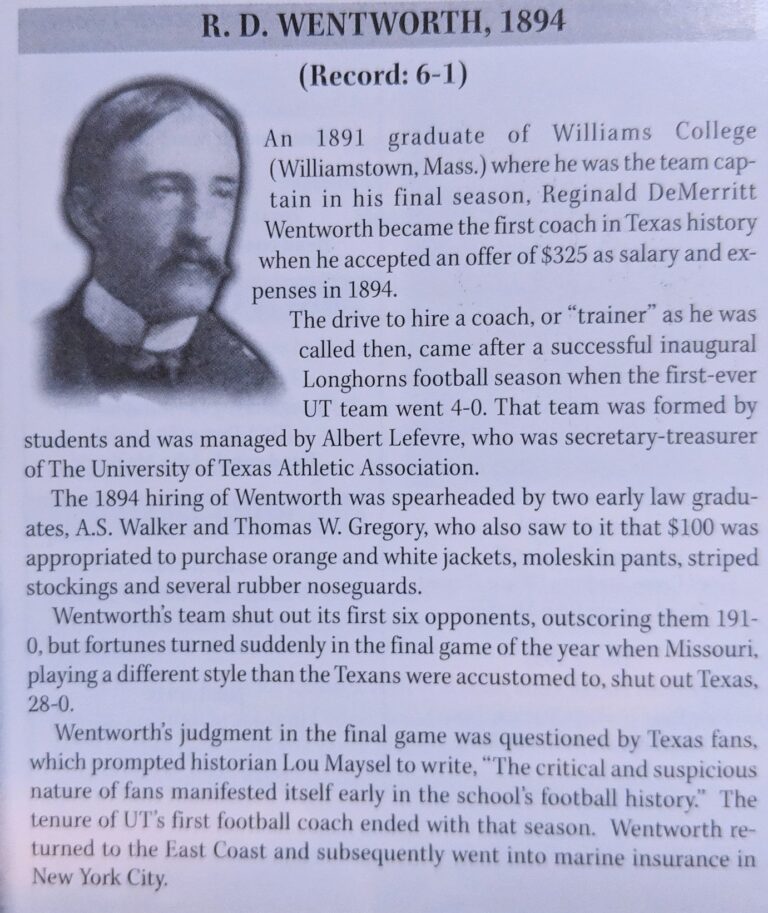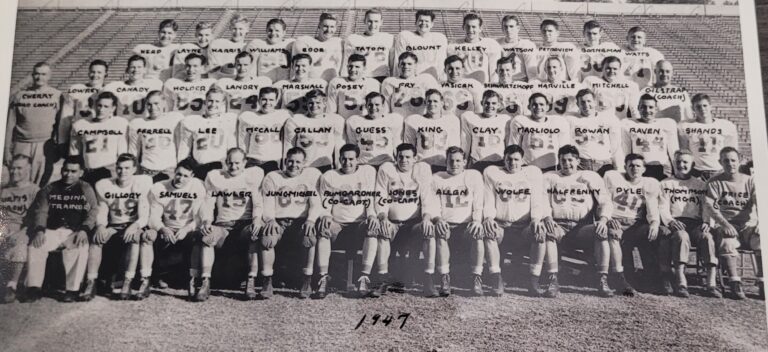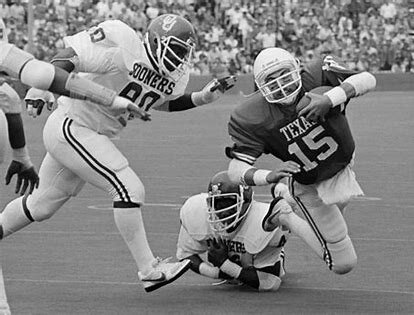1971 thru 1976 DKR
Arkansas Coach Jack Crowe says the Razorbacks seem to change their personality” for the Texas game.” “We became tentative because of whom we were playing,” In the 1989 game, “it was like we were walking in sand.”
1971 preseason video
1971 8-3 Injures Riddled This Team, But They Still Win The SWC.
A sportswriter implies that the reasons for all the injuries in 1972 were due to lack of proper conditioning. Royal’s response, “One player was lost because he broke his nose. How do you go about getting a nose in condition for football?
Eddie Phillips suffered turf toe, a hamstring pull, and a shoulder injury; Donnie Wigginton suffered several injuries that limited his playing time, forcing Royal to prepare Alan Lowry for quarterback duties if both Phillips and Wigginton could not play.
Donnie ties a Longhorn record for touchdowns in a season (14), leads the league in scoring, and is named the SWC’s most valuable offensive player by the Houston Post.
In the book “OU vs. Texas” Robert Heard quotes Royal as saying, “Phillips is the best running quarterback he ever coached. Coach Rogers From UCLA Says That Eddie Phillips “Was The Best At Running That Style Of Offense I’ve Ever Seen.” Royal Says That Eddie’s Ability To Delay The Pitch “Was Art.” After Eddie got hurt, Donnie Wigginton took over the wishbone and did a great job. Royal said about Wigginton, “I Think Donnie Wigginton should Be Given Consideration For The Most Valuable Player In The Conference.” He Leads The Conference With 84 Points.
Royal Says After The 1967 Recruiting Class Graduated “We’ll Be Back With Ordinary People.”
Season-ending injuries occur to David Arledge, Jimmy Moore, and Don Burrisk. Missing some action are Stan Mauldin, Eddie Phillips, Rick Davis, Bobby Callison, Jim Bertelsen, and Donnie Wigginton. In addition, Greg Ploetz, Ray Dowdy, and Glen Gaspard play through an injury.
4.4 sprinter Jimmy Moore is hurt, and Pat Kelly does a great job of replacing Jimmy. Before Don Burrisk gets hurt, Coach Royal said of Burrisk “runs like he’s got a motor in his seat. On the freshman team, he averaged 10.9 yards a carry, and that’s better than Saxton, Gilbert, or Bertelsen.”
Robert Heard says this was the weakest team since 1967. Penn State proved that point by beating the Horns 30-6 in the Cotton Bowl. Royal noted that Penn State was the most physical and strongest team the Longhorns had faced before the Cotton Bowl game. He was right. Eastern football reigned supreme for the first time in a long time. The Longhorns led at halftime, but fumbles and defensive miscues in the second half cost the Horns the game. As the “Cactus” states, the “Cotton Bowl loss climaxed a year of hope and letdown.”
Royal Wishes Jerry Sisemore’s Mother “Had Been More Considerate And Just Had Triplets.”
The article discuss’s Gary yeoman’s successful journey separate from his famed father.
Final ranking 18th nationally
Texas is the only school to play in 4 consecutive Cotton Bowls.
Royal says about President Johnson, “I learned from him that you could be a common man-and, at the same time, be a great man.
Lonnie Bennett Is The First Black Athlete To Score In A Varsity Game.
Coach Royal teaches OU head coach Chuck Fairbanks the intricacies of the wishbone against the advice of Emory Bellard.
Bellard takes the Head coaching job at A & M
Sisemore is an All-American. Braband was defensive MVP for the SWC. Dowdy, Ploetz, Lowry, Sisemore, Crosslin, and Bertelsen make the All-SWC team.
Dean Campbell finished 4th nationally in punt returns with a 16.6-yard average.
Penn State and Texas each received $435 205 dollars for participating in the Cotton Bowl.
1972- 10-1 #3 NATIONALLY- A GREAT YEAR FOR LONGHORN FOOTBALL BUT NOT A GREAT YEAR PERSONALLY FOR COACH ROYAL.
Royal referred to this team before the season started as “average as everday’’s wash.”
This was probably one of Coach Royal’s most rewarding years as the Longhorn football coach. But, unfortunately, he lost nine starters to graduation. Mike Bayer, Jerry Sisemore, Alan Lowry, and Randy Braband were the only players remaining from the 1970 national championship team.
Royal also lost Emory Bellard to Texas A & M, added Coach Tim Doerr, David McWilliams, Spike Dykes, Glen Swenson, and Alvin Matthews.
Royal received a raise to $40,000 a year.
Royal finally accepted hair length and mustaches.
Freshmen were allowed to “cross the creek” from freshman field to play varsity, and Marty Akins was is one of the first to do so. Akins spent his freshman year backing up Alan Lowry. He played in several games as the quarterback and as a kickoff and punt returner and played in the 1973 Cotton Bowl against Alabama, which Texas won. The Longhorns finished the 1972 season ranked #3.
Billy Schott’s three-pointers were instrumental in some key victories.
1972, Texas’s 4th straight SWC championship and 5th straight trip to the Cotton Bowl.
Rosy Leaks surpasses 1950 running back Byron Townsend’s record of 230 carries by 2.
Royal says about emotion before a game, “It’s something you don’t instill in a team.”
Coach Royal’s daughter Marion is killed in a car accident.
For the first time since WWII, freshmen were eligible to play varsity. As a result, freshman Guard Will Wilcox, linebacker Rick Fenlaw, and quarterback Marty Akins receive playing time.
For the first time in 101 games dating to 1963, Texas is shut out in a game.
In the book The Darrell Royal Story, the author states that Coach Royal is offered a head coaching job in the Pros but declines, saying, “I don’t want a big ol’ house and a lot of those things.” “I’ve never learned to live real fast and real luxuriously, anyway, so I thought about those offers, and it still came back to the same answer: I don’t want to fool around with happiness.”
President Johnson invites Jerry Sisemore, Alan Lowry, Randy Braband, Julius Whittier, and Roosevelt Leaks to his ranch for lunch
A team that Royal claimed is “as average as every day’s wash” finishes third in the nation. Horn wins its fifth consecutive SWC championship. OU is the only loss. The stadium is constructed, and 15,000 more fans attend the home games. Life is good!!!
Russell Erxleben Is One Of Only 2 Longhorns Listed As A 3 Time All-American. He Is Tied For The Longest Field Goal In NCAA History At 67 Yards, And He Still Holds The Record For Yards Kicked Per Punt At 42.4 Yards. UT head coach Fred Akers said of the 67-yard kick, “It was like a gunshot. We couldn’t believe a ball was going that far. It had another eight yards on it.” Erxleben kicked two other field goals over 60 yards that season.
The 3 game margin by which Texas won the SWC was the largest in league history.
National Championship Teams Require Good Recruiting, A Competent Coaching Staff, Players With Faith In The System, Trust And Respect For Teammates, Combined Talent, Team Chemistry, A Strong Work Ethic, And A Little Luck. With A Little Luck, This Team Could Have Been A National Champion.
Alvin Matthews becomes the first black coach in Longhorn history. He coaches the defensive backs.
Alan Lowry is “sensational,” said Arkansas coach Frank Broyles. “We must have missed 50 tackles on him.”
Jerry Sisemore gets credit for blocking four Mustangs on a 12-yard run by Lowry.
Glen Gaspard was the leading tackler in most games. Royal said about Glen, “He’s played as well as a lot of people who have made All-American here before.”
Alan Lowry And Jack Collins Hold The Longhorn Record For The Longest Punt In Texas Football History (82 Yards).
There Is Only One Longhorn Touchdown Pass In 1972, And Julius Whittier Catches It.
RECRUITING BLACKS FROM THE BOOK “OKLAHOMA VS. TEXAS” BY ROBERT HEARD
In 1972, Texas was unable to recruit a single Black player. In response, Robert Heard, with the approval of Coach Darrell Royal (DKR), co-authored a five-part Associated Press (AP) series focused on recruiting Black athletes at Texas. Heard mentioned that Royal had attempted to recruit Black players, but the “image” of the school as a racist institution perpetuated its own difficulties in attracting African American athletes. Royal believed that the seven African American players on the Longhorn team would clear him of any accusations of racism; however, the opposite effect occurred.
The situation was further complicated when the AP articles included quotes from six Longhorn players, indicating that they perceived some racism among the coaching staff. One of those players was Julius Whittier. In Jimmy Banks’s book, *The Darrell Royal Story*, pages 156-159, Banks recounts an interview conducted by the AP that featured Julius making some unflattering remarks about the University of Texas. After reading the article, Julius visited Coach Royal and explained that the interview had been a “pressure cooker,” saying, “I was really trying to help (UT) but was clumsy.” Royal replied, “If you were trying to help, you really were clumsy.” Ultimately, the issue was set aside, and Julius retained his position in the starting lineup. Beyond this incident, Julius and DKR maintained a close relationship during and after Julius’s time at Texas.
Piling on with a book of Fiction by Gary Shaw
Piling on Meat on the Hoof, written by Gary Shaw, also caused Royal some unjustified heartache. It was apparent that Gary Shaw was radicalized. There had never been a book like this written. George Sauer, a Longhorn, endorsed the book that portrayed DKR as a fraud. Shaw accused Royal of building a regimen that demeaned athletes, instilled fear, ignored human rights, implemented academic deception, and supported racism. Royal and many of his players defended his actions as head coach.
Most of his book is exaggerated, and many of his comments are not valid. I know. I played for Royal from 1967 to 1970. Royal was no Saint, but during the three years I played for DKR, I understood his role as coach and mine as a football player. He was not my best friend—he was my coach. Coaching is not a democracy; it is an autocracy, and if you want to play football on Saturday, you better make the Coach happy.
Most of the squad members viewed football practice as a chance to improve, move up, and earn a spot on the first team.
In the book “Coach Royal” by John Weeks, Royal said Gary “did not want to play football from junior high on…. ….his dad forced him to play…I know for a fact he did not want to play college football….. So a coach pushing him and pressing him into doing some things that he doesn’t like to do” will result in a bad experience.
Royal continues, “the book that Gary wrote expressed an honest view of a man who was out for a sport he didn’t like.”
Eventually, most of the racist comments and the book Meat on the Hoof were discredited, but the damage to Royal’s reputation remained.
Unsolicited, two of DKR’s players from the early 1960s – Gene Bledsoe and Marvin Kubin- negated much of the harsh rhetoric in Gary Shaw’s book. I commend both of them for their bold letters supporting Coach Royal.
GREG DAHLBERG
“A Texas attempt at a “Quick Kick” adds spying as a new scandal to SWC college football. Greg Dahlberg Lettered Three Seasons At Texas On Football Teams That Won The Southwest Conference Title All Three Years And Won The National Championship In 1970.
Dahlberg Was Inadvertently Part Of “Spygate” In The O.U. Texas Football Game In 1972. Coach Royal Had Installed The Quick Kick Into The Playbook For The First Time In Four Years, The Week Leading Up To The O.U. Game. With OU Holding On To A Slim 3-0 Lead Late In The 3rd Quarter, Texas Was Pinned Inside Its Own 10-Yard Line, And Coach Royal Decided To Quick Kick. Greg Was The Designated Center For This Kick, And When He Entered The Game, O.U. Players Immediately Began To Yell “Quick Kick, Quick Kick.” Texas Didn’t Change The Play At The Line Of Scrimmage, And The Kick Was Blocked. Lucious Selmon Fell On It In The End Zone And O.U. Went On To Win The Game. The Charges Of O.U. Spying On The Longhorns During Practice Plagued The OU-Texas Game Until Coach Royal Retired In 1976.
Longhorns were in the Cotton Bowl again, but that was a bad omen. The Horns were 1-4 playing there in recent years. Horns felt Jinxed, but this game would prove otherwise. DKR’s team won, and the losing streak at the Cotton Bowl was over.
Terry Melancon intercepted two passes against Alabama, and the season culminates with a win over #4 Alabama and a magnificent game by Randy Braband. He says He Is Going To Write A Book About The 5th SWC Championship In A Row For Texas. He says, “We’re Going To Call It Five In A Row, Or Cab Driver, One More Time Around The Block.”
All-SWC- Leaks, Lowry, Sisemore, Wyman, and Roach on offense. Braband, Gaspard, and Minnick on defense. Sisemore is a unanimous All-American.
Royal was secretly contacted by the New England Patriots and the New Orleans Saints about becoming their head coach, but Royal declined the offers.
Royal had compiled a 48-6-1 record using the wishbone from 1968-1972.
1973 – DKR 8-3 One of the most significant years in Longhorn football History
Larry interviews four members of the 1973 team at the link below.
https://www.texaslsn.org/1973-interview-with
Billy Schott talks about the Miami game and SMU games in the link below
https://www.texaslsn.org/1973-schott-remembers-miami-and-smu-games
Jay Arnold talks about the O.U. scandals at the link below
https://www.texaslsn.org/jay-arnold-and-the-19721973-ou-games
Royal entered 1973 with a heavy heart when his daughter Marian Royal Kazen died in a car accident. Royal says in the book “Coach Royal” by John Weeks, “Makes you understand that some things are not as important as you thought there were. It made me look at what I was doing in the game and the intensity, and maybe maybe it wasn’t all that important. I think I eased back and became a little bit softer and not quite as aggressive after that as a coach. I know we weren’t as demanding, probably after that, or I wasn’t. “
By 1973, Coach Royal received 40,000 a year, and 11 assistant football coaches received an average of $17,000 each, which was a lot of money during that period.
In the 1970s, the National Collegiate Athletic Association tried to control athletic scholarship formula to fund based on need and limit the number of scholarships. But the UT regents followed coach Royals’ lead and opposed these changes.
The UT faculty Senate proposed more students and professors on the athletic council but was declined by the Board of Regents.
Lowry graduated, and Akins took over as the starting quarterback and started every game despite suffering a broken big toe in the season’s third game. Texas defied predictions and won its sixth consecutive SWC Championship but lost to Nebraska in the 1974 Cotton Bowl. Marty was twice voted Chevrolet Television Player of the Game and was chosen the Southwest Conference Newcomer of the Year. Akins played in the Cotton Bowl despite having the flu and a temperature over 102 degrees.
Marty was the only Longhorn quarterback to start three seasons directing the Wishbone offense and the only Wishbone quarterback ever to be an All-American.
Gaspard and Wyman are named Captains of the team.
The first game against Miami was a disaster for the Horns, losing five fumbles. But, Royal said, “It’s the first time in my coaching career we lost a football game, yet never had to punt.” In the next game against Texas Tech, the Horns fumbled five times but only lost one.
Coach Royal’s salary was $40,000, and his 11 assistants received a salary averaging $17,000.
In 1973 the NCAA imposed a limit of 105 scholarships for football programs, essentially freeing up money for scholarships in other sports, especially women’s sports.
Austin American Statesman states:
“On the field, Texas went 8-3 but a perfect 7-0 in Southwest Conference play. The undefeated conference season yielded a sixth-straight SWC title. No. 3 Texas was surprised by unranked Miami in their first game and dropped to 2-2 on the season with No. 6 Oklahoma beating Texas 52-13, one of the worst losses Royal suffered to Oklahoma, who had promoted its offensive coordinator Barry Switzer to the head coaching job before the season.”
Ivey Suber’s Mother Tells Coach Royal That Barry Switzer Offered Her Son A New Wardrobe, A New Pontiac, And A $1000 If He would Sign With OU. Switzer Denys Allegations.
Texas was named the best college program from 1968-1972 with a 45-4-1 record.
The 1973 team Holds The Texas Record For the Highest Average Yards Per Punt Return ( 18.8), Fewest Punt Returns Allowed (6), And Fewest Punts In A Season (30).
Leaks Is 3rd In Voting For The Heisman. He Rushes For 342 Yards Against SMU, And The headline In A Newspaper Article States, “Roosevelt Leaks All Over The Field.”
Mike Presley says, ” Miami could not stop us. We stopped ourselves. But it’s good to get that National Championship stuff out of our heads. We probably realize the situation better now and can get down to winning the SWC. That is what we want to do.”
Many call Rosy the Southwest’s best fullback ever. Royal indicates there may be more Roosevelt and less pure Wishbone again this year. Royal is concerned about the inexperience of sophomore Quarterback Marty Akins to the offense, so he says, “Without the elusive, dangerous breakaway type back, “we’re going to have to make a little yardage each time we snap the ball.”
1972 and 1973 Rosy is All SWC – 1973 consensus All-American and 3rd runner-up for Heisman. He produces 12 – 100-yard games.
With 1415 yards, Rosy Leaks breaks the SWC record held since 1950, and he ties the SWC TD record with 14. He rushes for 342 yards against SMU. Rosy is the first black student-athlete to earn first-team All-American honors at Texas.
Click on the link for Rosy’s story: https://youtu.be/kj6JXXGxik0
Rosy left football with a message that should resonate with young athletes. “Athletics they can take away from you. Education is forever.”
According to the book The Darrell Royal Story by Jimmy Banks, Coach Royal told the team they must give 100% effort to beat Alabama. He said, “You might be able to fool the guy next to you or even the rest of your teammates, but you can’t fool yourself. That’s why I want you to commit to yourself, not everyone else.” Terry Melancon intercepted two passes to cement the victory over Alabama.
Coach Royal breaks Jess Neely’s record as the winningest coach in the SWC.
The New York Giants leaked word they were interested in hiring Royal.
Coach Royal Praises Bill Wyman Saying ” I Don’t Think We Have Ever Had Any Player Who Has Been More Consistent Than Bill Wyman.” Bill Wyman was nominated for the Outland and Lombardi trophies.
Photos of Bill’s induction to the Hall of Honor in 2010 compliments of Anne Crawford Cain, are below
My brother Bub Crawford and Anne with Bill’s award.
OU Hires Coach Jim Helms From Texas. Following is part of an article about Jim Helms’s negative impact on Texas vs. OU. This is part of an article written by Bill Little in 2013
The worst, however, was yet to come. Just before the season had started, archrival Oklahoma had raided Royal’s coaching staff with the hiring of Jim Helms, a former Longhorn running back who had just spent the last several years as a coach at Texas.
The last-minute hiring fueled the resentment at UT toward Sooner coach Barry Switzer, since Helms had been a part of all of the spring and fall preparations for the season. Whether or not Helms’ knowledge of Texas’ plans made a difference quickly became a point of contention, particularly after Oklahoma hammered the Longhorns, 52-13, and Helms is presented the game ball in the Sooner dressing room after the contest.
What followed, however, is one of the untold stories of a remarkable turnaround — and a lesson that would play itself out years later in another place and time. Texas was 2-2 as an angry Royal came into a team meeting the following Sunday.
Royal began by questioning the team’s desire and commitment, but before he had gone far into the speech, Arnold, who would become an all-SWC defensive back that year, interrupted him. “That’s not right, coach,” Arnold said from the back of the room. “They changed everything we had prepared for — stuff they had done last year and this year. We played as hard as we could. We were going full-speed to the wrong places.” The uneasy silence in the room was broken when defensive guru Mike Campbell spoke up. The 52 points OU had scored were by far the most ever against a Campbell-coached Texas defense. “He’s right, Darrell,” he said. “They seemed to know everything we were doing before we did it.”
Jay Arnold Is A Star After The Texas Tech Game With An Interception, And A Fumble Recovery In The End Zone. He Has Another Interception The Next Week Against Wake Forest.
WEIGHT LIFTING AT TEXAS CHANGEs FOREVER
Longhorn weight lifting changed forever in 1973. Jay Arnold says “We were part of the ‘old school’ when it came to physical and strength training.” “We would lift and condition in the spring and off-season, but put the weights away during the season. Oklahoma did it differently. They were working on weights all year long. We changed after that game and never looked back. We were in an era of enlightened transition as far as that was concerned.”
Cotton Bowl Nebraska 19 Texas 3
It was Nebraska’s Coach Tom Osborne’s first bowl victory, but the Horns held firm in the first half. Moving from their own 20, the Huskers used less than four minutes to reach the Texas one. The clock was down to 1:29. The first and goal turned into second and third down, and the ball was still on the 1-yard line. Each time, the Huskers were turned away by a solid Texas wall of defenders, inspired by linebacker Wade Johnston. The final blast came from Maury Damkroger, and Johnston was there to stuff him again short of the goal line as time ran out. The other half Nebraska received inspired leadership from backup quarterback Steve Runty who led the Huskers to two third-quarter scores.
Mike Atkins had a subpar performance giving Mike Presely an opportunity to compete for the starting position.
Wyman is a finalist for the Lombardi Award. In addition, 9 Horns make the All- SWC team – Simmons, Crosslin, Wyman, Leaks, Minnick, Rutherford, Arnold, English, and Gaspard.
In the Cotton Bowl, Johnston, who led the team in tackles during the season, was named MVP on defense in the Cotton Bowl game. Each team’s purse for the Cotton Bowl appearance was $475,092.
In the book, A Story of Texas Football, the author, Denne H. Freeman, says that in February 1974, four oral commitments changed their minds. It was the first time this happened in 13 years. Still, this was the best recruiting class for the Horns since 1967. The 1974 recruiting class made Akers’s first year in 1977 impressive. Earl Campbell, Rick Ingraham, Alfred Jackson, and Brad Shearer were part of this class. In addition, 10 of the 20 letters of intent signees were the top prospects in the state of Texas. Earl signed, saying, “Texas did not buy me. Blacks are through selling themselves..or at least I’m not going to sell myself…Texas offered me everything legal, and there was none of this stupid talk of cars and money.”
1974 8-4 DKR- Texas struggles while the SWC competition gets better
Campbell and Leaks in 1974 led Texas to an 8-4 record. Freshman Earl Campbell had 928 yards rushing and six touchdowns. Leaks had 409 yards and four touchdowns, while Wyatt had 590 and eight rushing touchdowns. Quarterback Marty Akins also had 659 yards and ten touchdowns (the team lead).
The scholarship limit is reduced to 30 per year. This is the first year that Texas had an 11 game format.
15 Freshmen made the traveling squad. The trip to Boston was the first time to visit the city by the Longhorn football team since Texas played Harvard in 1931.
Cactus Annual criticizes Royal saying, “Royal would have coached the Longhorns to another SWC championship if he could have found a remedy to a problem which plagued Texas all season long- the forward pass.”
Aboussie and Burrisk were the starting running backs. Then, Burrisk got hurt, and Graylin replaced him, becoming the second freshman to start as a freshman. Rick Ingrahm was the 3rd freshman, and Alfred Jackson was the 4th freshman to earn a starting role for Texas.
Coach Royal has a very bad day.
The once-proud Longhorns had a bad day against Texas Tech, and it appeared that the Texas-long reign of terror in the SWC was over. Royal said, “This is about as bad as I can remember us looking offensively in a long, long time.” Tech had not beaten Texas since 1968, The year that Texas started a six-year run as SWC champions.
Baylor beat Texas for the first time in 18 years. The victory is known in Waco s the “Miracle on the Brazos.” Baylor goes on an wins the SWC for the first time in 50 years.
Final ranking 17th nationally
Rosy’s Devastating Knee Injury Requires Reconstructive Surgery, And No One Thinks He Will Play Again. Doug English And All American Says That “Rosy Was On His Way To Being The Best Ever.”
The 1974 Team Holds The Texas Single Game Record For Points Scored Against A Conference Opponent – 81 Against TCU And Most Touchdowns In A Game.
The Yearlings Are Disbanded And Integrated With The Varsity.
Earl Campbell, Gralyn Wyatt, Travis Couch, Alfred Jackson, Brad Shearer, And George James Start At Least One Game As freshmen in 1974.
Coach Royal says about Earl Campbell’s stiff arm “It oughta be on an Arm and Hammer baking soda box.”
Starters Don Burrisk and Joey Aboussie are hurt and cannot play in the OU game, so Royal decides to move Raymond Clayborn to the offense. The media reports this change, and Royal is angry and closes practices for the first time since 1970.
Texas changes their defense secondary from 3-man to a four-deep secondary to reduce the threat of the deep pass for a touchdown.
Parker Alford Is Killed In A Car Accident. (See “Gone Too Soon” On This Website.)
Mike Presley Starts At Quarterback Against Wyoming
Coach Patterson Says That Brad Shearer, “Goes Till He Hears Glass Shatter.”
The unlikely duo of Earl Campbell And Doug English Team Up To Block A Punt Against Arkansas.
Mike Dean Kicks A Record 56 Yard Field Goal Against TCU. Leaks Mentors Earl Campbell And The Results Are Obvious. Rosy is As One Of The greatest Longhorn Running Backs Of All Time. Fred Akers Takes The Head Coaching Job At Wyoming. Baylor goes to the Cotton Bowl. Texas plays Auburn in the Gator Bowl – Auburn 27- Texas 3 Longhorns have four fumbles and three interceptions.
Bob Simmons receives a post-graduate scholarship
All SWC Longhorns include Campbell, Simmons, Wilcox, Shearer, Hamilton, and Clayborn
Marty is named the most valuable offensive player in the SWC.
Simmons, Campbell, and Akins are named All-Americans.
1975 11-2 Royal changes from “dance with who brung ya” to “Scratch where it itches.” Ranked 6th Nationally
45,000 Students were attending Texas in 1975.
Don Breaux Is Hired as an assistant Coach To Add More Of A Passing Dimension To The Longhorns, but running the ball still is the scoring machine. Wyatt had 451 yards and eight touchdowns in 1975, and Akins 777 yards while Campbell went for 1,118 yards and 13 scores.
Final ranking 6th nationally in 1975
Earl Campbell’s younger twin brothers, Tim and Steve, join the team.
In the book Oklahoma vs. Texas, author Robert Heard says, “Royal made a mistake when he did not leave Clayborn in the offensive backfield that would have given Texas at least one halfback with both speed and moves. Injuries continue to hurt the horns. Against O.U., two starters miss the game, and six others are injured during the game. David McLeod is lost for the season, and Gordon leaves with a scratched eyeball. Texas lost 4 of 5 fumbles against O.U.
Coach Royal complains that O.U. coming off of probation was allowed to play with players who were the reason for the punishment. It did not sit well with Royal that O.U. had a “monster team” in 1975 recruited through illegal tactics.
Texas experiments with the “Wingbone” and only the Aggies remaining on their schedule led the nation to score 35.3 points per game.
Shearer is named the defensive MVP for the Arkansas game. A game with 13 turnovers.
There was a 3-way tie for the SWC championship between A & M, Arkansas, and Texas.
This Team Holds The Texas Seasonal Record For Most Forced Fumbles (46).
Three-way tie in SWC with A & M, Hogs, and Texas. Texas Offense was in the top 3 nationally.
Houston joins the SWC
Marty Akins is injured against TCU and Ted Constanzo replaces him.
Marty wins 26 Games during his career as a Longhorn and is the only three-year starter during the DKR era. Unfortunately for this great quarterback, he never beat OU. Marty is the only option quarterback ever to be named to the Football Writers All American team.
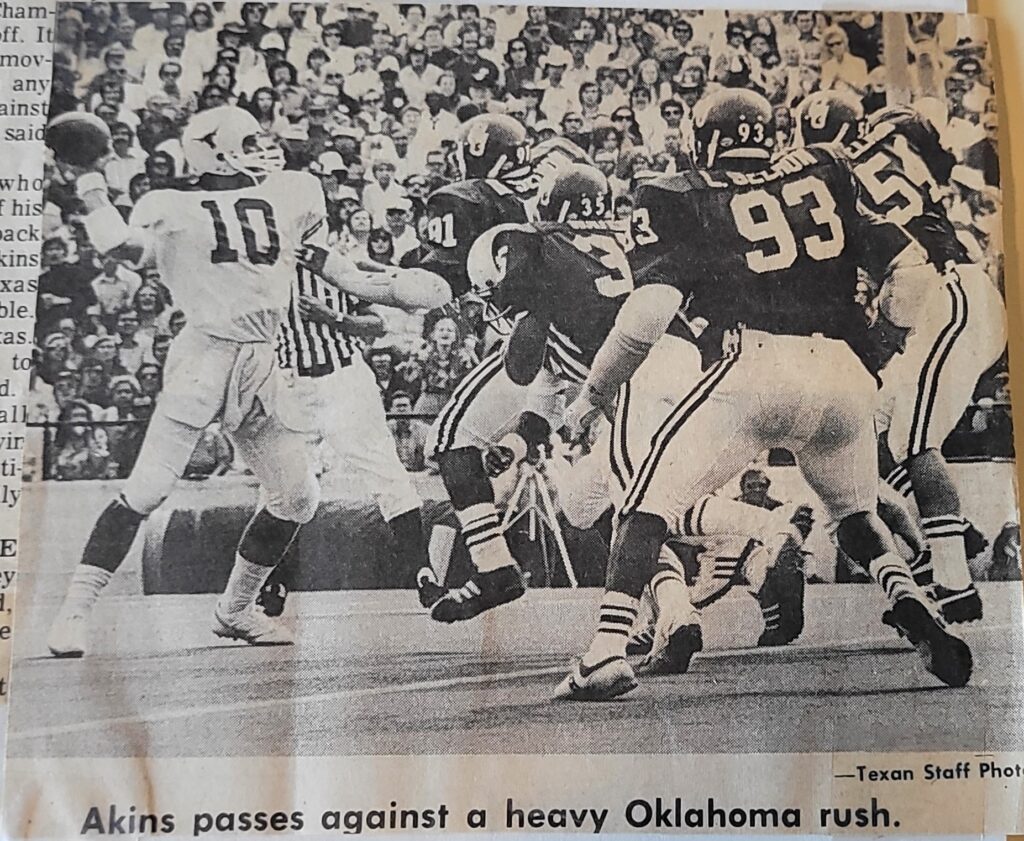
Royal Gets His 100th SWC Victory.
Switzer Throws Barbs At DKR. In The Book Long Live The Longhorns, Barry Switzer Is Quoted As Saying Some Coaches “Would Rather Sit Home And Listen To Guitar Pickers” Than Recruit. Referring To Royal’s Penchant For C&W Music.
Earl’s Brother Tim Campbell Is the Defensive Player Of The Astro-Bluebonnet Bowl against Colorado, and his brother Earl Campbell is the offensive player of the game.
On the offensive side, Marty Akins, Earl Campbell, and Bob Simmons, Will Wilcox, lead the team. On defense, Brad Shearer, Rick Fenlaw, and Hamilton lead the team.
1976 5-5-1 A quarterback dilemma
Royal receives a raise to $50,000 a year, but Spy-Gate, U Of H Breaking Texas 42 Home Game Winning Streak, Earl Campbell’s bad hamstrings, and recruiting violations made 1976 a challenging year for the Longhorns.
Houston joins the SWC and embarrass’s Texas at home, ending a 42 home game winning streak.
For the first time since 1967, Texas did not receive a postseason invitation.
Three highly recruited quarterbacks compete for the starting quarterback position- Ted Constanzo, Mark McBath, and walk-on Mike Cordaro, all play a prominent role in this season as the starting time as UT quarterback.
Mark McBath gets his first start at quarterback against TCU. Texas wins 34-7.
Mike Lockett and linebacker Lance Taylor get plenty of playing time as freshmen. Lam Jones, Johnnie Johnson, and Russell Erxleben spend some time on the injury list. Fourteen starters missed two or more games in 1976.
In the book Oklahoma Vs. Texas the author Robert Heard quotes Royal as saying he never wanted to win a game as much as the O.U. game in 1976. The game ended in a 6 – 6 tie and Royal got physically sick before he could reach the bathroom. Blackie Sherrod of the Dallas Times Herald said “Royal looked like he had driven a gravel truck without a windshield nonstop across Death Valley.”
For the first time since 1911, the Longhorns lost consecutive games to the Aggies, and it was only the second time the Aggies had won in Memorial Stadium in 20 years.
Baylor holds the Horns to 14 net yards of rushing offense. McBath says about the Baylor game “ We were in there looking for a win. They were looking for blood.”
OU assistant coach Lacewell resigns in 1978 and admits that the Sooners spied on the Longhorns.
For the first time in Longhorn football sports history for the A & M game, the Horns had an all-freshman backfield quartet.
Royal says that 1976 was a perfect year to leave the profession. He said, “I always wanted to leave somebody’s house when they wanted me to stay a little longer. It’s a good idea to leave a little ham on the bone.”
“I’ve always said nobody will ever have any trouble getting me out of the party. If I see a yawn, I hit the door real quick. I didn’t want to stay here until I wore out my welcome and I don’t think I have.”
Royal always said that when he retired, winning the last game would have extra meaning. No one wants to go out a loser. He got his wish when Texas beat Arkansas, the final game of the year in 1976. Tony Constanzo said after the game, he knew he was living a “snapshot in history.”
Only Clayborn and Erxleben make the All SWC team, and both are All-Americans.
Royals final game- Texas vs. Arkansas December 4th, 1976 in Austin, Texas.
For the first time in 25 years, Royal did not talk to the team before the pre-game meal. For the first time, he chose to lead the team out of the chute personally, and for the first time, he gave the Hook’em Horn sign before the game as the Longhorn band played. Royal said he spent the day brushing away tears and that leaving was harder than he anticipated. “you don’t just turn your back on 2o good years – and walk away and not feel it. “
After the game, he continued his tradition started in 1961 to famed room 2001 at the local motel to discuss the just-completed game. Royal said, “I’ve enjoyed it, I really have.
Royal says the only pressure for him as a coach was self-impose. He never felt pressure to perform which originated from the UT administration.
As is true of Royal his whole tenure at Texas, he gave the media the quotes they needed to sell newspapers. One reporter asked him, “are things much different than when he first started”? Royal responded, “ I’d hate to paint a dark cloud. There have been many changes, drastic changes. Things that used to get by with a phone call now take an original and 15 carbons.”
Royal shared with one reporter that he wanted to win, but that he learned more from getting beaten than winning.
Walking away from the game, he felt the University would allow him to name his predecessor, but that was not the case. Two influential UT regents, Frank Erwin and Alan Shivers were determined that Athletic Director Royal would not be permitted to handpick the new coach.
DKR Reflection Point
“Dig, claw, wheedle, coax that fanatical effort out of players”, Royal once said . “You want them to play every Saturday as if they were planting the flag on Iwo Jima.”
Jenna McEachern in the “Royal Scrapbook” states that Royal’s mission was to shape his players into first-rate men. By example and instruction, he imparted to them the importance of class, integrity, punctuality, hard work, and fairness. It was said by journalist Holland McCombs “They may kill you, but they’ll be polite about it.”
Doug English said in the book Darrell Royal” Dance With Who Brung Ya, “Suddenly, Darrell looks up and a game that he’s worked his whole life in a game of who works the hardest and prepares the best wins- has become a game where the ones who cheat the best, the ones who spy the best, who lie the best are all gaining ground.” Royal was “not going to listen to an 18-year-old kid tells him that that he’s got to buy him a new pickup truck to come to the University of Texas”.
Robert heard stated about Royal, “He couldn’t beat Oklahoma without cheating. And he wouldn’t cheat.”
Many in the media also called him a racist.
SpyGate, cheating, pandering to recruits, articles that suggested he was a racist, and his first non-winning season all sapped Royal of his passion. Coach Royal conceded that winning did not excite him anymore, and he found it challenging to recover mentally from losses. He also said, “Climbing is a thrill. Maintaining is a Bitch.”
Of the factors mentioned above, the evolution of recruiting disgusted him the most. Royal thought it was inherently wrong to court athletes to give them a college education to play football. He said, “it’s all backward; the kids should be coming to us, not us going to them.”
In the book “Longhorn Football” by Bobby Hawthorne, Robert Heard noted that Royal “ felt sullied by what recruiting had become: groveling at the doorstep of 18-year-olds with a scrapbook full of press clippings he could barely read.” Steve Ross says, “One of the reasons coach Royal decided to “set his bucket down” at such an early age was the changing recruiting landscape. He used to tell the story of his last recruiting year. He has a home visit with a student who isn’t back from practice yet. Royal sits with the mom in the living room when the recruit shows up. He first tells the coach, “You’re sitting in my chair, man.” “Coach said he jumped right up. And on the way back to Austin, seriously began to consider getting out.”
During his tenure at Texas, Royal was the winningest coach in the nation.
The Associated Press
The media chose to share unsubstantiated garbage articles about Royal to dethrone him.
In 1970, Bob Green of the Associated Press quoted Coach Royal as saying, “The black coach had not reached the point where his coaching is as scientific as it is in the major colleges.” This statement was completely false! Although an apology was published, the damage had already been done. Green claimed he had been misled by a source he considered a friend.
Royal later mentioned that if he had known then what he knows now, he might have sued the Associated Press. The article’s falsehoods were used against Texas in its recruiting efforts. Following its publication, many people began to question Royal’s commitment to recruiting black athletes.
After the article was released, Royal found himself constantly on the defensive, as other universities used it as a recruiting tool against Texas. Despite dominating the rivalry over 20 years of playing the Aggies, many Texas A&M fans still respected Coach Royal, referring to him as a “sweet Bear Bryant.” Bryant chuckled when he heard this description.
Royal’s resignation was a surprise and a disappointment to the Longhorn faithful but not to Bobby Dodd.
Bobby Dodd, the former head coach of Georgia Tech, sent Royal this note congratulating him on retiring at the right time.
Abe Lemmons sums up the problem that occurs when losing follows success. He said, “You build a monster, and the monster eats you.” DKR and Abe have this quote in common.
Royal wanted to change the recruiting process.
Royal wanted to see changes in the recruiting process, noting that both young high school athletes and the universities recruiting them often make critical mistakes. He observed that most high school students are thoughtful and polite, and they struggle with how to say no without hurting the recruiter’s feelings. Royal emphasized that the most natural time for a high school athlete to decline an offer is during the initial contact with a recruiter. The longer an athlete keeps a recruiter in suspense, the more difficult it becomes to say no.
He questioned why thousands of high school students manage to choose a college each year without experiencing significant emotional turmoil, while only the athletes being actively recruited and their families seem to suffer from meltdowns. Royal remarked, “The parents and recruits who initially look forward to the attention from major collegiate football programs go from welcoming coaches with open arms to shutting the door on them.” He acknowledged, “We know we can abuse the prospects and their families during recruiting, but it’s a two-way street. The families and prospects also have a role in this.”
In the book “A Story of Texas Football” by Denne H. Freeman, Royal confides that being successful in recruiting can have its disadvantages, especially in relation to competing universities. He reminisced about the Longhorns’ success in the 1960s when they enjoyed back-to-back national championships and defeated Oklahoma six times in a row. During that time, only true Longhorn supporters seemed to cheer for Texas, as Royal stated, “That’s just the nature of man—we root for underdogs. I pull for underdogs! I like to see someone else share a little bit of that success.”
He noted the old saying, “Even your best friends don’t like to see you too successful,” is indeed true; people prefer to see a little bit of wind taken out of someone else’s sails. As a result, recruiters from other universities would exaggerate or even lie about Royal and Texas to attract potential recruits. Claims like “Royal is a racist,” “At Texas, you are just a number,” “The school is too liberal and allows drug use,” and “You will never start at Texas” were all desperate attempts to sway recruits.an-spirited remarks that, on the surface, appeared credible and eventually hurt Royals recruiting.
But, unfortunately, a lie told long enough becomes the truth.
While Gary Shaw’s book Meat on the Hoof is full of exaggerations and half-truths, it was a best seller. Royal decided to respond to the allegations in the book and explain why players rebel against him and his coaching style. Here are a few quotes and some paraphrased comments from Coach Royal found in the book The Darrell Royal Story by Jimmy Banks.
-
Royal said, “Any time somebody sits on the bench, you’ve got a potential family of enemies. Every year, there are potentially “100 enemies” sitting on the bench.
-
“A guy would have to be a stone idiot to love going out there and just running into someone else. What is natural about two guys backing off and running into each other? It’s not natural.” The players play this unnatural sport because they want “recognition…as individuals, but also for their team, school, or hometown.” Players want letter jackets because it is a form of recognition.
-
“I often tell parents. If you send me a good one. I’ll send you a good one back. But if you send me a weak one, I’ll probably return a weak one. I don’t take credit for the strong character of our championship teams; the mommas and daddies deserve that credit. But neither do I want to be blamed for some player who comes in here lighter than a June frost and can’t stand the competition.”
-
“All the glory can’t be heaped just on the team. The personal, individual aspect has to come in there.”
In the end, Royal left Texas with the quote, “You can’t win against cheaters.” It was the right decision for Coach Royal.
After retirement, life was good!!!
Royal said, “Many coaches feel that a boy doesn’t have to like you as long as he respects you. But if I had respect, discipline, and all that- and a boy left this school without a personal feeling for me, it would be an empty profession.”
Coach Royal By The Numbers
Coach Royal ended his career with a record of 167-47-5. His teams won 109 SWC games, 11 SWC championships and won or shared four national championships. During his tenure there was a 30 game win streak, a 42 home game winning streak, a record 6 SWC titles in a row, 6 Cotton Bowls in a row, 77 All SWC players, and 26 All Americans. His teams finished in the top 10 ten times, and he guided Texas to 15 postseason games winning 8 of them. He was “coach of the decade” for the 1960’s, one of only two coaches honored twice as the American Football Coaches Association, and he never had a losing season.
Assistant Coaches
Royal was a great teacher of assistant coaches
Photo above Darrel Royal, Willsey (head coach at California) Swarthout (head coach at Montana), Campbell, Jones (Athletic Director at Texas Tech), Schulze, Pittman (head coach at Tulane and TCU), Shira (head coach at Mississippi State)
Bloody Mike
In Jenna McEachern’s book “100 Things,” she discusses Coach Mike Campbell. She quotes Freddie Steinmark from 1970, who remarked, “Coach Campbell, I must say, is a genius in his own way. I’ve never been associated with a man any smarter in addressing not just football problems but all kinds of challenges.”
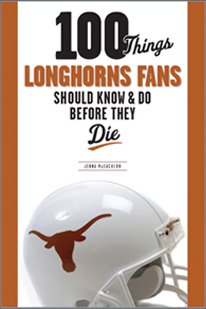
Coach Campbell is wise in the world’s ways and explains things in blunt, straightforward language to ensure understanding. When a reporter asked if a certain overweight lineman, a former top recruit, would contribute to the team, Campbell replied, “When he graduates and joins the Longhorn booster club.”
Campbell’s philosophy was, “A confused player cannot be an aggressive player.” Doug English added, “It wasn’t a chess game. You had to beat the guy in front of you.” Campbell understood the nuances and tendencies of opposing offenses, effectively removing the element of surprise from their plays.
**Coach Zapalac**
In 1964, Coach Zapalac was hired from Oklahoma State and spent 12 years at Texas. During five of those years, at least one of his offensive linemen was named to the All-American list. Zapalac was a standout high school player for Bellville in 1930, known as the back that opponents feared the most. He had the ability to defeat them by running over or around them, blocking them to the ground, tackling them on defense, punting over their heads, or recovering on-side kicks in their end zone, as he did against Caldwell. In that game, Zapalac ran for 323 yards and scored two touchdowns, and he had another outstanding performance with 308 yards against La Grange. He earned All-State honors in his last two seasons, rushing for 2,565 yards at nearly 10 yards per carry as a senior and scoring 245 points.
At Texas A&M, Zapalac was a formidable blocker at fullback, served as team captain in his senior year, and played in two East-West Shrine Games and the College All-Star Game in Chicago. He flew 32 bombing missions during World War II and became an exceptional coach at various levels, including high school, junior college, university, and the NFL. Coach Zapalac passed away at the age of 89 on May 18, 2010.l coach at various levels, including high school, junior college, university, and the NFL. Coach Zapalac passed away at the age of 89 on May 18, 2010.
Coach Campbell: “If you keep going until the glass breaks, I will find you a place on our team.”
Coach Campbell was an exceptional defensive strategist. He was direct and straightforward, ensuring his players understood his message. He resembled a general from WWII—kind of like a lean Patton. Tommy Keel, a defensive back under Coach Campbell, noted, “On the practice field, he’s a hard man…you can’t be friends with him. But his techniques are effective, and he gets a lot of effort out of us.”
Coach Campbell believed in the “firm correction” of athletes. He had no reservations about embarrassing a player in front of their teammates for poor performance. Players often found Campbell’s sharp tongue amusing—at least until they found themselves on the receiving end of it. However, one thing was clear about Coach Campbell: fiery criticism for a mistake was a positive sign. As Tom Campbell remarked about his father, if he stopped yelling at you, it meant he had given up on you, and you would likely never play again.
Doug English commented on Coach Campbell, saying, “It wasn’t a chess game. You had to overpower the guy in front of you.” Coach Campbell was adept at identifying the strengths of opposing offenses and effectively neutralizing those advantages. Dan Mauldin, the hero of the 1965 Orange Bowl, admired Coach Campbell, stating, “I just like to watch Coach Campbell coach… of all the professors at the University of Texas, he understood his field better than they understood theirs.” Despite being offered the head coaching position at Baylor, Coach Campbell declined the opportunity.
Coach Manley
Coach Manley and Coach Royal were childhood friends in Hollis, Oklahoma. They played high school and College ball together, and Royal was Leon Manley’s player-coach in the CFL. Coach Manley at OU, Northeast Louisiana, and worked with Coach Royal for 20-plus years.
Coach Emory Bellard at the link below:
https://www.texaslsn.org/emory-bellardwishbone
Coach “A little Dabb will do ya”Ken Dabbs
A link to a great article written by Kirk Bohls about Ken Dabbs induction into the Hall of Honor is below.
CLICK ON LINK BELOW TO LISTEN TO THE GATLIN BROTHERS SING THE EYES OF TEXAS.
https://www.facebook.com/GatlinBrothers/videos/10154235201426835/

